

We write Stevens history
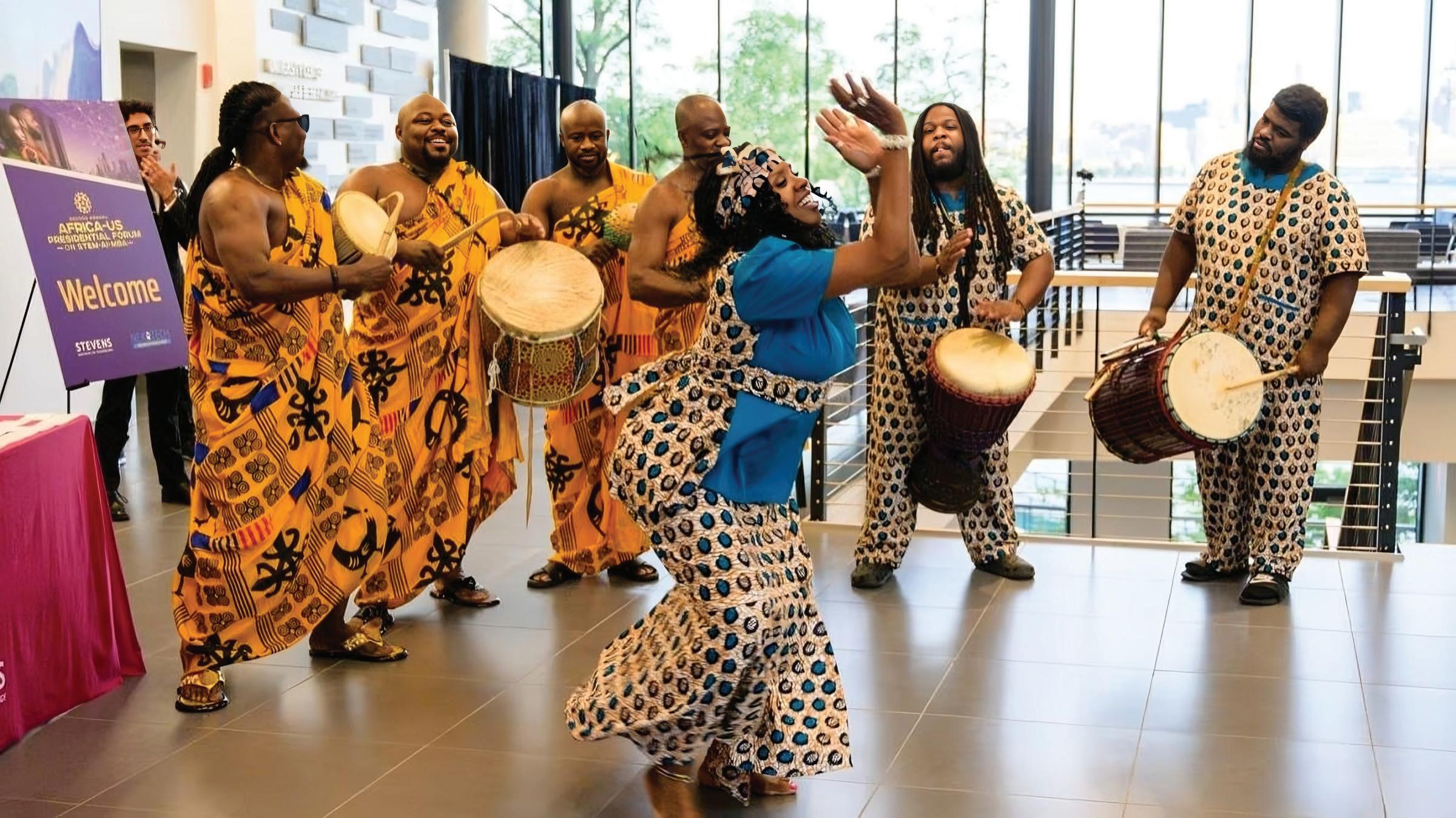
Stevens hosts international forum to enhance STEM education between Africa and the U.S.
BY EVAN PAPAGEORGE, HEAD COPY EDITOR
The second annual Africa-U.S. Presidential Forum, hosted on Castle Point in the University Center Complex’s TechFlex for the first time (the event was last held at Rutgers University) in collaboration with the Nekotech Center of Excellence, brought together leaders from across the African continent, technical experts, and state officials for a day dedicated to advancing educational opportunities in STEM
A
for African students. The forum, held on September 19, focused on promoting access to advanced degree programs in artificial intelligence and MBA programs tailored to technically minded scholars. This year’s event marks a deepening partnership between Stevens and Nekotech and a broader effort to enhance Africa’s position in the global technology and innovation landscape. The Stute had the opportunity to speak with President Farvardin about the event and learn more. At the heart of the fo-
breakdown of the 2025 U.S. News college rankings and where Stevens placed
AMANI KARIM, CONTRIBUTOR
The ranked lists of American colleges by U.S. News & World Report, likely the most well-known and consequential set of such rankings in the country, was released last month. In line with recent years, Stevens placed 76th overall and placed highly in major categories like Best Undergraduate Teaching, Most Innovative Schools, and Best Undergraduate Engineering Programs.
Based on statistics from the U.S. News & World Report, the most prestigious and highly ranked schools have high graduation rates, high starting salaries, and lower median student loan debt burdens upon graduation. To be eligible for consideration, the institution must be located in the United States and have regional accreditation. It must also be designated as a “bachelor degree-granting institution” but not be classified as highly specialized, maintain at least 100 undergraduate students, have a six-year graduation rate for full-time first-years, and be actively accepting applications. A highly specialized school is a trade or technical school or a school that does not
have a baccalaureate degree graduation rate.
Each university is generally judged in five main categories: teaching, research environment, research quality, international outlook, and industry engagement.
Teaching refers to the overall setting and learning environment in which education takes place. According to the American Association of Colleges and Universities back in 2021, the need for an inclusive campus and “relevant and engaging curricula” is increasing to promote success and assimilation in society.
Research environment is the quantity of research output produced by a university. This includes the number of publications, projects, and patents made. Additionally, the finances allocated to research activities from government funding enhances the research environment. This ties into reputation, which is perceived quality of prestige dependent on the universities achievements.
Research quality or excellence encompasses how well research is designed, executed, and evaluated. Citation impact, a large in-
SEE RANK PAGE 2
rum is a shared vision between Stevens and Nekotech: to create a pipeline of highly skilled African students equipped to transform their home countries and industries. Nekotech, co-founded by H.E. Rev. Dr. Princess Asie K. Ocansey of Ghana, has spent years fostering these educational ties, placing students at U.S. universities through a combination of unsecured loans, sponsorships, and prep scholarships. The initiative aims to support 10,000 African students annually, with a recently announced $1 bil-
lion allocation for educational loans over the next five years.
Dr. Ocansey, who cochaired the event alongside Stevens President Nariman Farvardin, emphasized the transformative power of education in addressing Africa’s economic needs.
“Through this sponsorship, we aim not only to transform the lives of individual students by empowering them with the skills to shape technological progress but also to strengthen the economies of Africa,”
How a $10 million gift kickstarts iSTEM 2.0+
JOSEPHINE CHOONG, STAFF WRITER
On September 20, Stevens announced a $10 million gift from Stevens Emeritus Trustee and engineer Emilio A. Fernandez to expand iSTEM. Combined with anticipating matching gifts of $7.5 million, it brings iSTEM’s total external investment to a potential $17.5 million, supporting the launch of more thrilling opportunities. iSTEM was launched in 2019 and aims to encourage talented students who experienced struggles or boredom within a traditional classroom environment but demonstrate exceptional creativity. It was inspired by Fernandez and his similar academic experience. Fernandez states he would have benefited from programs like iSTEM and is proud to support Stevens in nurturing iSTEM students to reach their full potential. He came to understand the importance of education through his father. After Fernandez’s family migrated from Cuba, his father rebuilt their lives through his principles and education, which were the only assets no one could take away.
Mukund Iyengar, Founding Director of iSTEM@Stevens, illustrates that the program nurtures a specific kind of talent. It’s for students who want to innovate and
build instead of sitting inside a classroom. Those students have the passion, problem-solving skills, and entrepreneurial drive to configure groundbreaking technologies and businesses. These ideals are reflected within the admission requirements by offering flexibility, allowing students to self-identify and apply. iSTEM provides resources to create pioneering inventions and revolutionary enterprises within the right environment. Since its debut, iSTEM has achieved remarkable success with a 95% retention rate, 15 graduates employed in large corporations or early-stage companies, the creation of at least six new enterprises, and over $5 million in capital raised by student ventures. Within the next three years, the increased funds will evolve from iSTEM 1.0 to iSTEM 2.0+. Iyengar explains it will help student projects take a quantum leap forward. It will aid students in breathing life into their ideas and bringing products devoted to solving difficult human problems using technology. Throughout those years, iSTEM will enhance the recruitment and identification of students and increase the number of students from 12 to 20 per year. To aid the students, they will imple-
The Stevens Gala to recognize a year of innovation
BY EVAN PAPAGEORGE, HEAD COPY EDITOR
It is the time of year again when Stevens is gearing up for its much-anticipated Awards Gala. This annual event celebrates the remarkable contributions of its alumni and faculty to technology and engineering. Scheduled for October 5, at the picturesque Chelsea Piers in Manhattan, the 2024 gala promises to be a night of inspiration, recognition, and networking.
The event honors those who have significantly impact-
ed their communities and professions, reflecting the institute’s commitment to fostering innovation and leadership. Award nominations are now closed to allow for decisions to be made as we look to alumni and faculty to recognize their peers who exemplify Stevens’s values and spirit.
“Stevens is proud to celebrate the achievements of our community members who are pushing boundaries and making meaningful contributions across industries,” said President Nariman Farvardin. “The Awards Gala is an opportu-
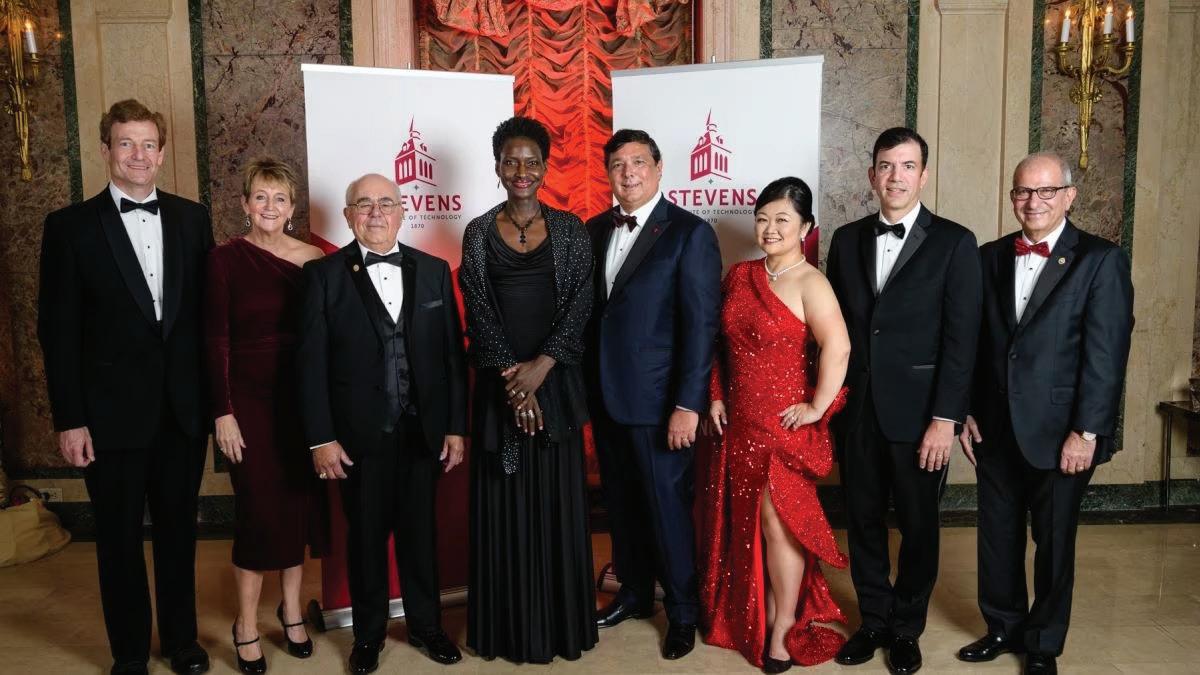
nity not just to acknowledge these individuals, but to inspire future generations to follow in their footsteps.”
The nomination process is straightforward and
encourages participation from all corners of the Stevens community. Nominees must be alumni, faculty, or
SEE GALA PAGE 3
Nebraska governor halts effort to change Nebraska’s electoral voting from proportional allocation system
BY SEAN ANDERSON, STAFF WRITER
In about a month, the citizens of the United States will be voting to determine the next president to lead the country. With the little time left before election day, both political parties have been taking action to support their party’s candidate through several means. Specifically, members of the Republican party were driving an effort to alter how electoral voting works in Nebraska, a state that uses a proportional allocation system.
For most states, the electoral voting system follows
a winner-take-all format in which all of its electoral votes go to the candidate who wins the popular vote of that state. Only two states have the alternate system: Maine and Nebraska. Nebraska began using their system in the 1992 election, and since then, it has only had an effect twice. Nebraska typically votes Republican, but in the 2008 and 2020 election, Barack Obama and Joe Biden, respectively, received one electoral vote from the 2nd district in the state.
The 2nd district’s recent lean towards voting for Democrats sparked this new effort to revert Nebraska’s system to the original win-
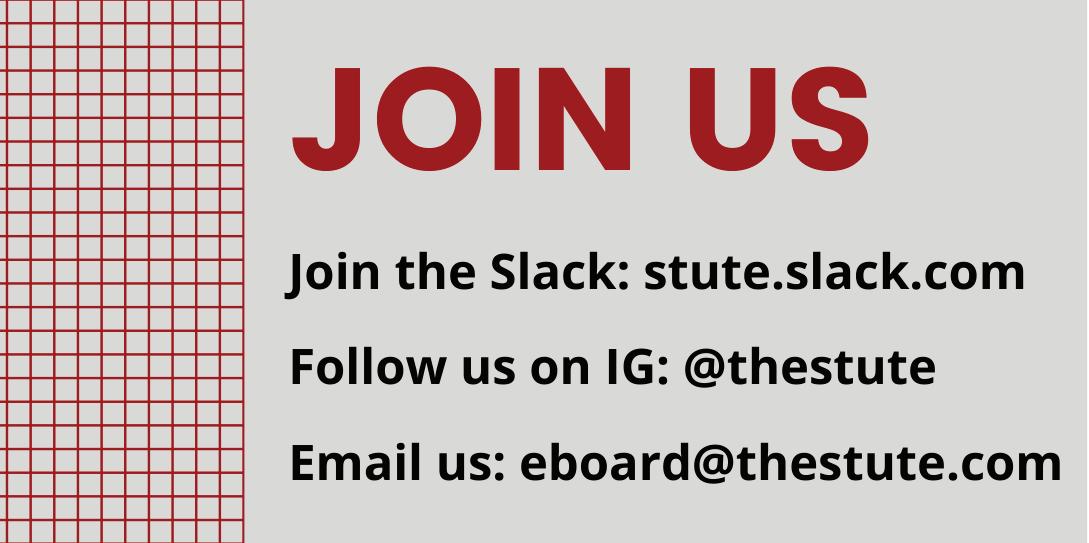
ner-take-all system. Earlier in the year, Nebraska Governor Jim Pillen put his support into a GOP-led bill that would make such a change.
According to the New York Times, Jim Pillen stated that, “It [the bill] would bring Nebraska in line with 48 of our fellow states, better reflect the founders’ intent, and ensure our state speaks with one unified voice in presidential elections.”
However, on September 24, Pillen ended this effort. According to CNN, Pillen stated that he has “no plans to call a special session” in order to continue the effort. He adds,”Unfortunately, we could not persuade 33 state senators.” With the lack of 33 votes, including that of Republican Senator Mike McDonnell who announced shortly prior that he would not support the last-ditch effort, and with little time before the election, this is likely the end of the effort for now.

This is not the first time that there has been an attempt to revert the system. There were efforts back in 1995, 1997, and most recently in 2016. PBS reported in 2016 that “The effort was derailed after supporters failed to overcome a legislative filibuster, just as they were on
SEE VOTE PAGE 3

PHOTO COURTESY OF STEVENS.EDU
2022 RECIPIENTS AND ATTENDEES, PHOTO COURTESY OF STEVENS.EDU
Masthead
Executive Board
EDITOR-IN-CHIEF......................................ISABELLA ZIV ‘25
BUSINESS MANAGER............................TANYA AVADIA ‘26
MANAGING EDITOR..............................ARTHUR SERRA ‘27
LAYOUT EDITOR................................JIYA JAISINGHANI ‘27
OUTREACH CHAIR.........................................AVA WANG ‘25
DIGITAL MANAGER...................................ABBY JACOBS ‘27
SECRETARY..........................................NICOLE GIARDINO ‘25
HEAD COPY EDITOR.....................EVAN PAPAGEORGE ‘26
Editorial Board
NEWS EDITOR.........................................BEN KNOBLOCH ‘25
SCIENCE EDITOR..................................RIYANA PHADKE ‘27
OPINION EDITOR....................................TASHA KHOSLA ‘25
SPORTS EDITOR................................RUTHIE MULLISKY ‘26
FEATURES EDITOR...................................TIANNA SPITZ ‘27
PULSE EDITOR........................................MIA PETROLINO ‘25
Operations Board
HEAD PHOTOGRAPHER RAFAEL LEE LI ‘25
Layout Team
ASSIS. LAYOUT EDITOR............VICTORIA OKONKWO ‘28
DELIVERY BOY.........................................JONATHAN LAI ‘28
Staff & Contributors
Advait Dantuluri
Josephine Choong
Amani Karim
Sean Anderson
Jeylan Jubran
Amelia dela Cruz
Erin McGee
Camryn Winant
Charlie Beall
Abby Thomas Prisha Vagvala
Madison Heller
Kevin Castner Jr.
Stephen Pachucki
Jack Scherban
Emily Martinez
.............................BUSINESS@THESTUTE.COM
OFFICE.................................UNIVERSITY CENTER ROOM 216B
NOTICE A MISTAKE? Email us at eboard@thestute.com.
All opinions and editorials reflect the views of their respective author(s). No Part of The Stute may be reproduced in any form, in whole or in part, without the written consent of the Editor-in-Chief. Cited references of The Stute are permitted.
All members of the Stevens community are able to submit a Letter to the Editor to be published in The Stute. Letters must refer either to a piece published in The Stute or to The Stute in general and must be between 400 – 800 words in length. Submit letters to editor@thestute.com with your name and title (when applicable) or using our Google form. For writers who wish to write a Letter to the Editor anonymously, please see our policy on anonymity.
The Editorial Board reserves the right to choose whether or not to publish a submitted Letter to the Editor based on a majority rule vote, and additionally reserves the right to edit letters for clarity or request authors to revise. Provided that the author approves the final version, The Stute reserves the right to edit letters according to our copy editing procedures, defined in our policies.
All members of the Stevens community are able to submit a standalone opinion piece (otherwise known as an Op-Ed) to be published in The Stute. Op-Eds must be between 400 – 800 words, but longer submissions will be considered on a case-by-case basis. To submit an OpEd please email eboard@thestute.com with your name and title (when applicable) or using our Google form (tinyurl.com/submit-t0-stute). For writers who wish to write an Op-Ed anonymously, please see our policy on anonymity.
The Editorial Board reserves the right to choose whether or not to publish a submitted Op-Ed based on a majority rule vote, and additionally reserves the right to edit Op-Eds for clarity or request authors to revise. Provided that the author approves the final version, The Stute reserves the right to edit Op-Eds according to our copy editing procedures, defined in our policies.
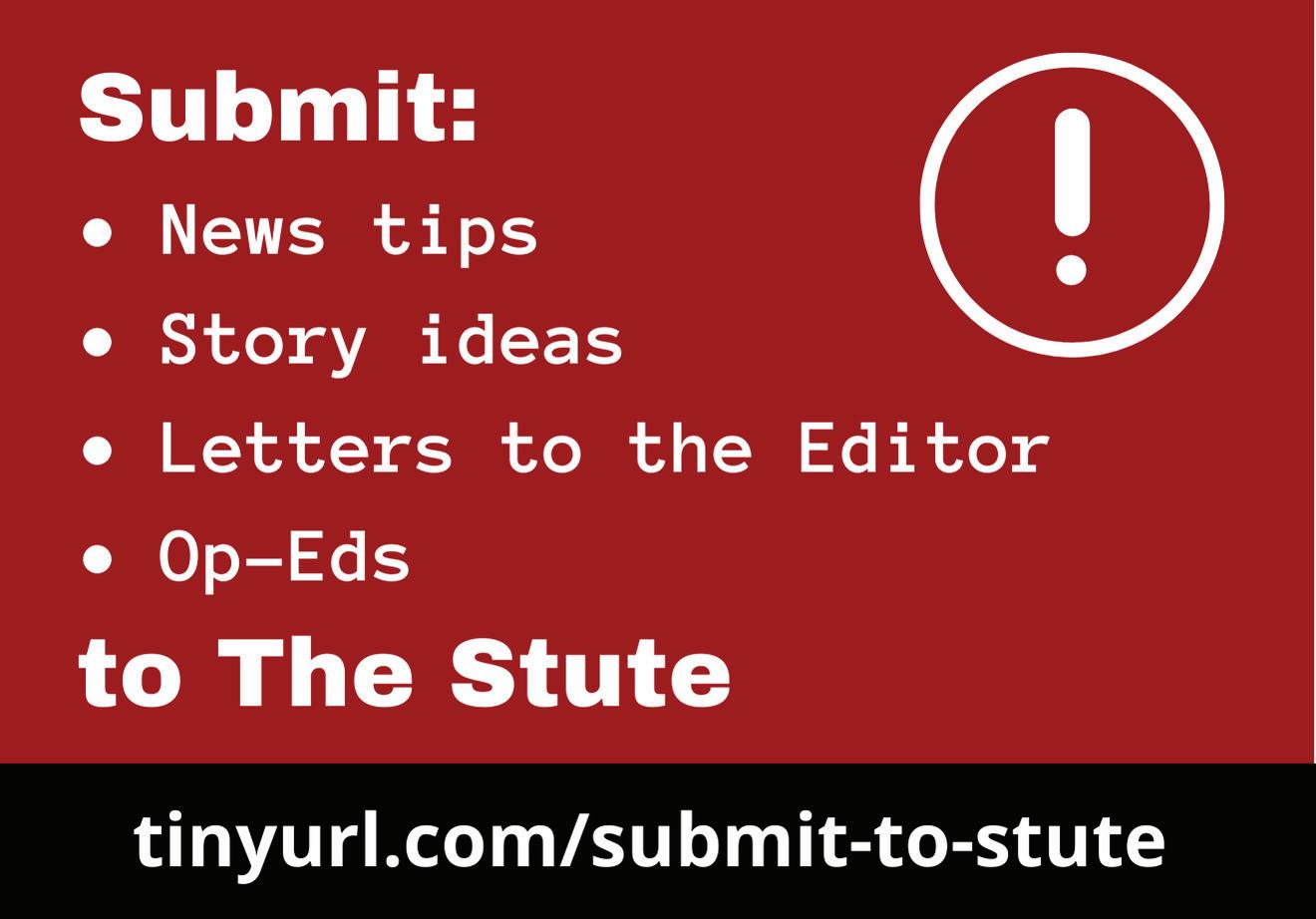
STEM CONTINUED FROM PAGE 1
said Ocansey. The event also highlighted Stevens’ commitment to serving as a hub for the next generation of African innovators.
President Farvardin underscored the importance of preparing students for an unpredictable technological future. “At Stevens, we do not just prepare students to master the technologies of today; we equip them with the agility to excel in the technologies of tomorrow,” said President Farvardin. “This mindset ensures our students can thrive in rapidly changing environments.”
This year’s forum intentionally coincided with the United Nations General Assembly, drawing African dignitaries already in the region. Dignitaries included a king from Ghana, the President of Malawi, and approximately 60 ministers and vice presidents from various African nations, including Ghana, Malawi, Chad, Liberia, Sierra Leone, and Zambia.
Many noted the cultural richness of the event, with President Farvardin describing it as a fantastic evening with speeches, food, and culture featuring a unique mix of traditions. A no -
RANK
CONTINUED FROM PAGE 1
dicator of quality research, is a measuring tool of how often research publications are cited from other professionals. The quality of research is based on the impact the research has on the educational community, industry practices, and policy decisions. It also incorporates the number of grants and investments attracted. Quality research leads to innovation and can influence educational and environmental policies, and even public health.
International outlook, or global perspective, pertains to the diversity of staff and student body, which includes study abroad programs and international partnerships. Industry income is the collabo-
table feature of the evening was the presence of Ghanaian royalty seated on elaborate thrones, with additional seats reserved for other esteemed guests, including a queen from Ghana.
Stevens’ Dina Iskaros, Director of Graduate Admissions, was instrumental in organizing the event, ensuring that the logistics were seamless, with a wide range of African nations represented. Much from Iskaros’s work, the event had plans for every detail, coordinating everything from the awards ceremony to the themed chocolate bars made for the occasion — one each featuring the King of Ghana, the President of Malawi, and President Farvardin himself.
Nekotech’s work ensures that students receive a world-renowned education and then return to their homes. As the forum continues to grow, Stevens and Nekotech hope that more African students will take advantage of these educational opportunities, contributing to Africa’s longterm economic and technological development.
With this year’s forum’s success, Stevens has already extended an invitation to host next year’s event. President Farvardin noted that everyone seemed to rejoice at the evening’s success, adding that both Stevens and
rations between colleges and companies, revenue generated from research projects, and the amount of patents filed, which all reflect the universities contribution to technological advancements. This is calculated using data from industry incomes and patents.
According to U.S. News and World Report, Stevens ranks #76 overall as a National University on the 2025 edition of Best Colleges, tying with three other schools. Stevens is also #33 in Most Innovative Schools, #56 in Best Undergraduate teaching, #63 in Best Value Schools, and #71 in Best Undergraduate Engineering Program. A joint ranking by Wall Street Journal and College Pulse placed Stevens as the 36th best college in America.
The outlet’s top five American universities remain unchanged from last year. Princeton University topped the list, followed
Nekotech were honored to have facilitated such meaningful conversations and collaborations. As Africa continues to invest in STEM education, partnerships like the one between Stevens and Nekotech will play a critical role in shaping the continent’s future. They will prepare a new generation of leaders to address global challenges through technological innovation.
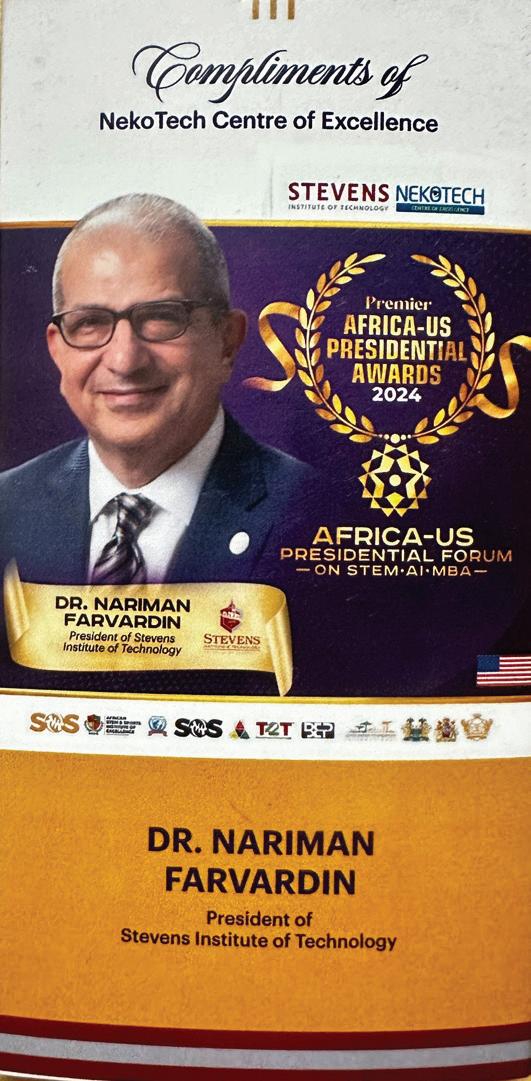
by Harvard University, Massachusetts Institute of Technology, Stanford University, and Yale University. Princeton University remains the top university in the United States for the 14th year in a row. The top schools were generally untouched, yet 20 lower level colleges advanced 50 spots in the rankings due to a new methodology.
Letting these statistics speak for themselves, Stevens showcases its reputation for excellence in higher education. The wide reach of these rankings by U.S. News means the university continues to tout strong results, and reflects past and current strategies to strengthen the school’s performance in areas that might affect its placement. Whether the strategies in place now mean Stevens will continue to grow in recognition remains to be seen.
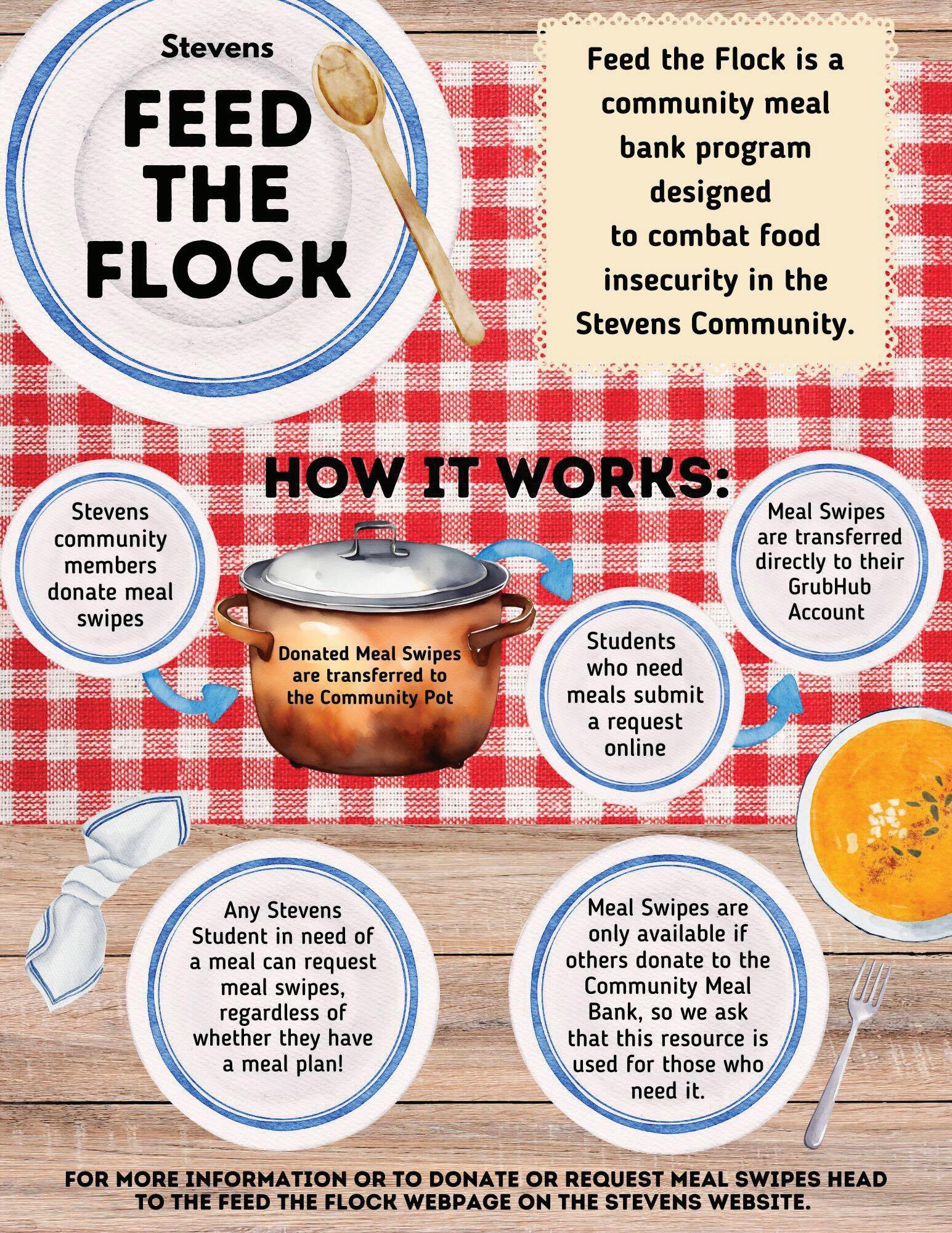
EVAN PAPAGEORGE FOR THE STUTE
GIFT
CONTINUED FROM PAGE 1
ment a pre-college summer program, strengthen academic monitoring, reinforce support systems, and formalize an active iSTEM alumni network.
Iyengar states after iSTEM 2.0+ is implemented, the broader vision is to export iSTEM to other institutions. Fernandez and others have been identifying the right schools and finding ways to prop -
CONTINUED FROM PAGE 1
staff members who have contributed exceptionally in their respective fields. Nominees for the various awards are evaluated based on their professional accomplishments, community involvement, and commitment to the institute’s core values. Categories include the Distinguished Alumni Award, the Outstanding Young Alumni Award, and the Faculty Achievement Award. The gala honors these achievements and is a crucial fundraising event for the institute. Proceeds from the evening will support scholarships and initiatives that enhance the educational experience for current and future students.
agate iSTEM. Stevens’ program will serve as a model, leading to the creation of an iSTEM network across the nation. “iSTEM should become a new model for education,” Iyengar explains. “It should redefine what the meaning of pursuing a technical degree stands for.” To further establish the program’s long-term sustainability, Stevens will initiate the iSTEM Endowed Fund. Furthermore, in honor of Fernandez’s support, the Startup Garage, a makerspace, will be named the Emilio A. Fernandez iSTEM Startup Garage.
President Nariman Farvardin explains, “We are immensely fortunate that Emilio A. Fernandez’s creative genius and insightful vision inspired the iSTEM program at Stevens and that his continued involvement and support will ensure the program achieves its greatest potential.” He adds, “Our iSTEM students exemplify the innovative spirit that defines Stevens. By providing access and support to these exceptional students, we are cultivating the creative minds needed to tackle global challenges.”
October begins with a spate of campus events
BY ADVAIT DANTULURI, CONTRIBUTOR
Are you looking for exciting things to do on campus? Well, you’re in luck, because student organizations are back in full swing and a large number of undergraduate events are teed up for early October. Let’s run down all the major events happening on campus over the week of October 4 to October 11.
welcoming back the first Stevens-Latina graduate and enjoying free tacos and nachos. There will also be a Giants vs Seahawks watch party with food starting at 4:30 p.m. for the loyal New Jersey football team fans.
The gala is a chance for the Stevens community to commemorate the achievements of all in its community and celebrate a future of innovation and learning at Castle Point. Beyond its purpose of honoring award recipients, the gala also offers a chance to recap the accomplishments of the entire university over the past year and lay the groundwork for the goals and aspirations of the upcoming years. Attendees will have the chance to network with leaders in technology, engineering, and entrepreneurship while enjoying a curated evening filled with gourmet dining and engaging presentations. The evening’s program will include keynote speeches from influential figures in the tech sector and testimonials from past award recipients who share how their time at Stevens shaped their
careers. As Stevens prepares for this grand celebration, anticipation builds for the accolades and the connections forged among attendees. The gala is expected to draw a diverse crowd of alumni, faculty, and industry leaders, all eager to celebrate Stevens’s spirit and support the next generation of innovators. Its honorees will attend the event, including technology industry executives, healthcare pioneers, international diplomats, Stevens leadership, students, and alums. In a time when technology and engineering continue to evolve rapidly, the Stevens Awards Gala is a testament to the enduring impact of education and community engagement. It reminds us of institutions like Stevens’s profound role in shaping the future, one award-winning alumnus at a time. GALA



Every day of the week Stevens Serves co-hosts community service events with the Undergraduate Student Life office to volunteer at the Hoboken shelter. There are breakfast, lunch and dinner shifts you can schedule yourself for. Next week from Monday to Thursday, you can also volunteer through Stevens Serves at the Lunchtime Ministry at St. Matthew Trinity Church in Hoboken.
On Friday, October 4, Counseling and Psychological Services (CAPS) is hosting a first year support group where students can speak openly about their experiences with a CAPS counselor. The Stevens Climbing and Mountaineering Club (CAM) has revived their rocking climbing trips and this week they are going to Method Climbing Gym in Newark. Climbers of all levels are welcome and more information about the costs, waivers, and RSVP details can be found on Ducklink. If you can’t make it this Friday, CAM will be going to Gravity Vault in Hoboken on October 7 and back to Method next Friday, October 11. Additionally, The Stevens Christian Fellowship is hosting a Fellowship Dinner and a Game Night, and Hillel is hosting a Rosh Hashanah Shabbat. SITTV is showing the recently released thriller movie Twister at 6 p.m., Undergraduate Student Life is hosting a Casino Night at 6:30 p.m., Stevens A Capella is hosting a Karaoke Night at 7 p.m., Theta Phi Alpha is holding a Crepe Night fundraiser starting at 8:00 p.m., the Anime Club is showing “Matriculation” starting at 9:15 p.m..
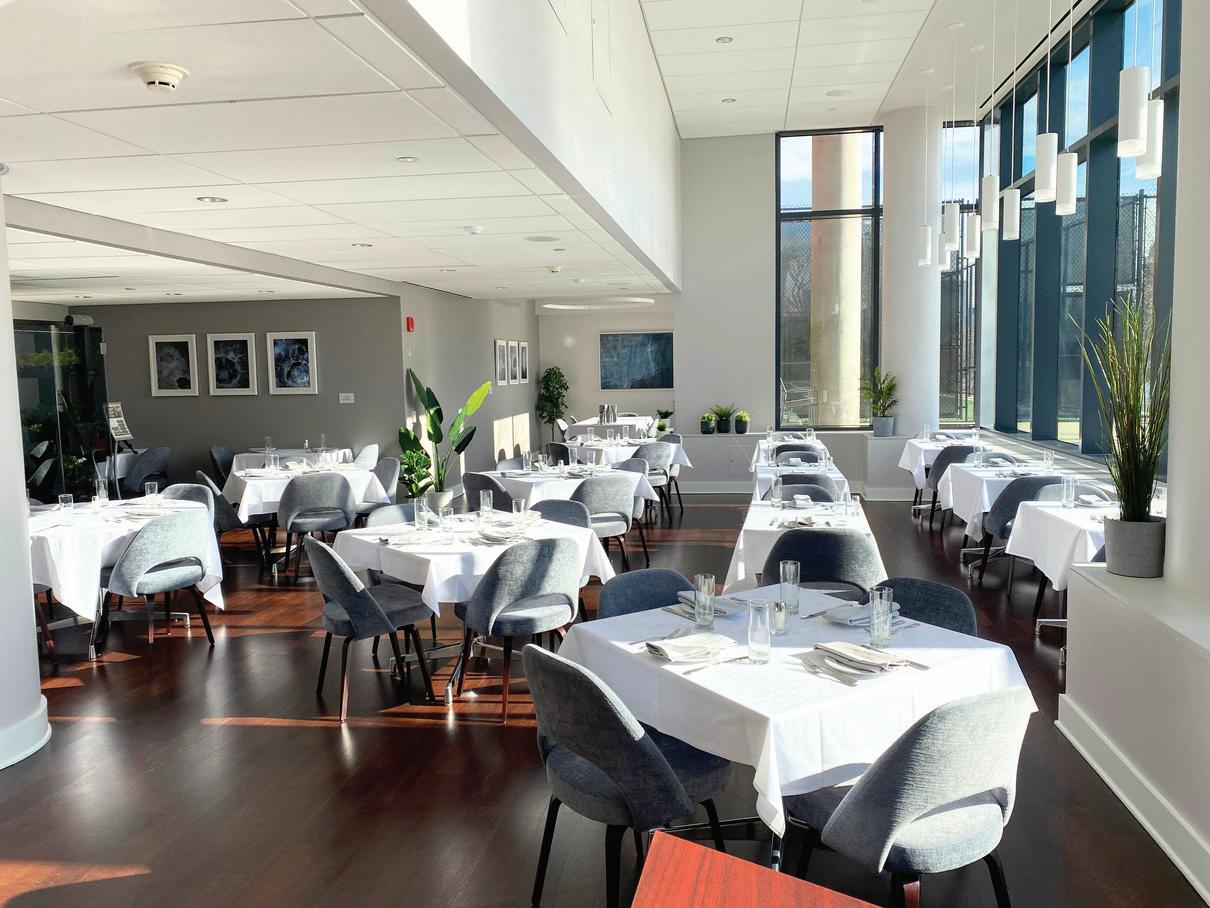

lunch for you and three guests! The winner will be announced on our Instagram story

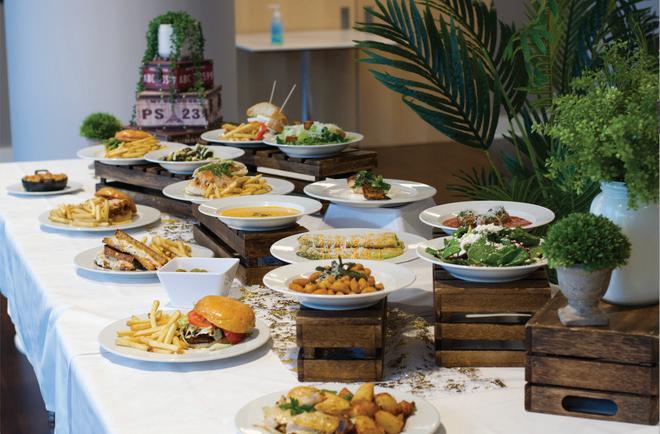



This weekend, the Entertainment Committee (EC) is going to Hershey Park and is seeing Gracie Abrams in concert. Although signups for these events have passed, the next EC events will be Travis Scott on October 9 and the Jets vs Bills on October 14. Be sure to look out for the signups on Tuesday, October 8 at 10p.m..
On Monday, October 7, Alpha Phi Omega is hosting a bake sale to spread awareness about breast cancer since October is Breast Cancer Awareness Month. This bake sale will run Tuesday and Wednesday as well. The Office of Student Culture and Belonging is hosting a Lavender Link-Up for the LGBTQ+ community at Stevens to socialize and network, while Torch Alliance is doing TRANSit: Gender and Donuts, a community hangout for transgender and nonbinary students.
On Tuesday, Sigma Psi Zeta is hosting its fourth annual fundraising thrift store to raise funds for Domestic Violence Awareness Month, and Sigma Phi Epsilon is doing a bake sale for Breast Cancer Awareness Month. The Stute is collaborating with SAVE and Art Installations Club to hold a newspaper art night. Attend to reuse newspapers in a creative way and take some art home with you.
On Wednesday, check out the Hoboken Public Library’s (HPL) BookBike outside the library to get your HPL library card and learn how to design patterns with Redshift.
On Thursday, the Office of Student Support is holding their Strive to Thrive event on Palmer lawn with community wellness resources and free depression screenings. CAPS will also be hosting their LGBTQIA+ support group.
If you’re not exhausted from all the events on Friday, on Saturday Undergraduate Student Life is hosting an Arts and Crafts Workshop from 2-3 p.m. and the Audio Engineering Club is holding their first open mic of the school year. Go support fellow students and enjoy free food and music at the Autumn open mic.
On Sunday, the SIT Historical Society is celebrating Hispanic Heritage Month from 12-3 p.m.,
VOTE
CONTINUED FROM PAGE 1
Finally, on Friday, October 11, the Office of Student Culture and Belonging is hosting National Coming Out Day as well as the Ducks Barbershop where you can get a free haircut with professionals who specialize in serving Black, Indigenous, and people of color (BIPOC) clients.
These aren’t all the events! Check out DuckLink to see a full list of all that’s happening on campus and to get more information on dates, times, locations, and
the brink of approving it.” There were reasons noted for why the bill did not pass in the end. According to PBS, Democratic Senator Tanya Cook of Omaha stated that the winner-take-all system “will result in no-choice elections where one party has a permanent monopoly on power.” Former Nebraska state senator DiAnna Schimek, who sponsored the original bill to establish the system, commented that “I thought it would inspire more people to get involved,” noting that she felt people would feel more represented in the election if the state proportionally appointed its electors.
Due to all this, the 2nd congressional district of Nebraska, which includes Omaha, the largest city of Nebraska, has become a critical election battleground for the two candidates. With that being said, according to AP News, Harris has spent $5 million in the district since she entered the race and has more than $6 million in ad time up to election day, while Trump has only spent $95,000 with around $6,800 for ad time reserved up to the election. With both candidates very close in the polls right now, every electoral vote is going to count.
In a world of changing voting rules, don’t let your voice get lost.
New Jersey’s voter registration deadline is October 15!
Visit https://www.vote.org/voterregistration-deadlines/ to learn more about your state’s deadlines.
THE STUTE PRESENTS... NEWSPAPER ART!
In Collaboration with SAVE and Art Installations Club
OCTOBER 8 | 9:15 PM | GATEWAY SOUTH 216
eboard@thestute com @thestute

Voting as a Stevens student frequently
asked questions
How can I register to vote in Hoboken?
You can register using your Stevens address! (1 Castle Point Terrace Hoboken, NJ 07030)
You will need a NJ ID/license OR Social Security Number for non-NJ residents. Visit https://voter. svrs.nj.gov/register to learn how to register.
Note: There are good reasons for registering and voting at your college address or your home address, but keep in mind, the final decision is yours.
What if I registered to vote at home?
If you registered at home but want to vote in Hoboken, no problem! You can register to vote at multiple addresses or states, as long as you only vote in the election once. Voting twice is a felony - Don’t do this!
If you registered at home and want to vote at home without travelling back, you can request a vote-by-mail ballot. Check your state deadlines to request on time.
Where can I learn more about voting?
library.stevens.edu/vote/ www.nj.gov/state/elections/vote-students vote.gov/guide-to-voting/college-student
When is the deadline to register to vote?
The New Jersey voter registration deadline is October 15! Check your registration at
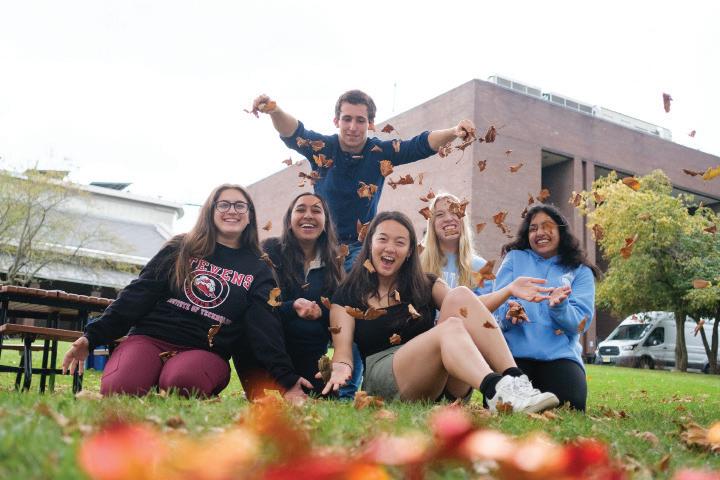
Feature
FALLING FOR FALL
Why we love fall so much What autumn reveals about climate change
The season of change, cozy moments, and Gilmore Girls

the air is crisp, the leaves are a golden blur, and there’s the un mistakable scent of pumpkin spice wafting through coffee shops. Fall is here, and for many, it feels like the world’s collective sigh of relief after the intensity of summer. But what is it about this season that touches something in our souls?
To put it in the words of Lorelai Gilmore: “I love snow. Hot cocoa, cozy sweaters, cute boys in scarves. There’s nothing better than fall weather.” There’s something about the season that just fits, like slipping into a favorite sweater that’s been tucked away for months.
The first reason for this is the charm of change.
Fall is a season of transition. As the world shifts from the brightness of summer to the more muted tones of autumn, we experience nature’s most colorful display. It’s a visual reminder that change can be beautiful.
The first chilly morning feels like a fresh start. Whether it’s the return of your favorite fall TV show (hello, Gilmore Girls rewatches!) or the excitement of pumpkin patches and Halloween preparations, fall invites us to embrace change with open arms.
The second is the cozy vibes everywhere!
There’s no denying that fall is synonymous with comfort. It’s the time to swap out iced coffees for warm lattes, and trade beach days for cozy nights with a good book or a little Good Will Hunting rerun. The smell of cinnamon, the warmth of a fireplace, and the softness of knitted blankets all contribute to the coziness that makes fall feel like home.
With the coming of fall comes a plethora of fall traditions and fun.
ed houses, fall comes with a set of ward to all year. These moments provide a chance to connect with son together. And who can resist the pull of a pumpkin patch or the allure of a corn maze?
As the weather cools down, our cravings shift toward hearty, comforting meals. Fall is the season of food that warms our souls. From savory soups, roasted vegetables, and indulgent baked goods. There’s something about enjoying a slice of warm apple pie on a chilly evening that just feels right!
As the days grow shorter and the golden light of autumn begins to fade, there’s a quiet beauty in knowing that this season, like all others, won’t last. It reminds us to savor each moment, much like Noah Kahan’s lyric, “I know I’m losing light, but it won’t last,” urging us to embrace the impermanence of fall and all its fleeting charms. Fall often encourages a sense of introspection. As nature begins to slow down, so do we.
Finally, we can’t talk about fall without mentioning fashion; there’s a reason why fall is often af fectionately called “sweater weath er.” Just like The Neighbourhood’s hit song, fall wraps us up in its comforting embrace, inviting us to bundle up in layers, sip hot drinks, and watch the world transform.
Fall is more than just a sea son — it’s a feeling. It’s a sense of warmth, comfort, and excitement bundled into shorter days and cooler nights. Whether you’re a Halloween connoisseur or simply someone who loves the changing leaves, fall invites us to slow down and savor the little things.
BY AMELIE DELA CRUZ, CONTRIBUTING REPORTER
After a summer of heavy rainfall, many in the United States are looking to enjoy a stark but beautiful change in season and weather. However, as research has shown, climate change may shift many autumn processes in a way that affects humans and the entire natural world.
The rise in average temperatures and humidity over the past few decades has had a significant impact on the way leaves fall during autumn. Higher average temperatures cause delays in leaf aging, which results in a delayed fall season. This is opposed to how lower average temperatures that have been seen in the past will slow the production of chlorophyll and advance aging. Increased humidity and the weather that causes it, however, can have a much greater impact. Heavy wind and rainfall can cause leaves to come off of trees before they even change colors. What’s worse is that an increase in moisture can promote fungal diseases on the leaves of trees and even fall food crops. These diseases
cause leaves to turn yellow, develop brown spots, and fall sooner.
In contrast, freezing temperatures during autumn prevent leaves from turning deeper hues like reds and purples. Severe frost can also damage a tree. Decreased moisture in the form of drought and wildfires has additional effects on nature during fall, some of which can be devastating. As is the case with many impacts of climate change, drought advances leaf aging, color change, and leaf drop. As for wildfires, ash from nearby fires can deposit onto leaves. This may hinder photosynthesis as leaves will have less surface area to capture sunlight needed for the process. In extreme cases of wildfires, portions of the forest canopy can be destroyed, overall diminishing the ecosystem.
Additionally, tourism, colloquially named “leaf peepers,” is a major source of revenue for states with the most vibrant fall colors, but this becomes a problem when the falling of leaves becomes more unpredictable with the weather.
Many northeastern states are seeing the impact of unusually warm autumns, which could cause them to lose out on a billion-dollar industry that promotes travel just for fall
foliage. However, since some travel practices are unsustainable and further damage the environment, it is advised that people are conscious of the way they enjoy nature.
But of course, humans aren’t the only animals feeling the heat when it comes to these new autumnal changes. Short-distance migratory birds have been found to leave later than average. Meanwhile, long-distance birds have been migrating earlier. This makes for a greater span of time in which birds have been migrating; the previous average timeframe for birds to leave was September to November, but warmer temperatures increase the timeline from August until December. The habits of insects have also been changing, with increased reproduction as a result of advanced development. They have also been migrating and hibernating later than in previous years, though this is not a heavily researched topic. So if the leaves don’t turn those classic fall colors anytime soon, don’t fret; it could just be a sign of the later autumn trend. It’ll never be too late to grab an apple cider donut and enjoy a nice autumn breeze.
The Stute E-board’s Fall faves
BY JIYA JAISINGHANI,
It’s that time of year again! September 22 marked the end of Summer and the start of Autumn! With the crisp air, colorful leaves, cozy sweaters, and pumpkin spice lattes, it’s no wonder people love the fall. In honor of the beginning of the season, I asked the Stute e-board what their favorite part about Fall is.
Ava Wang
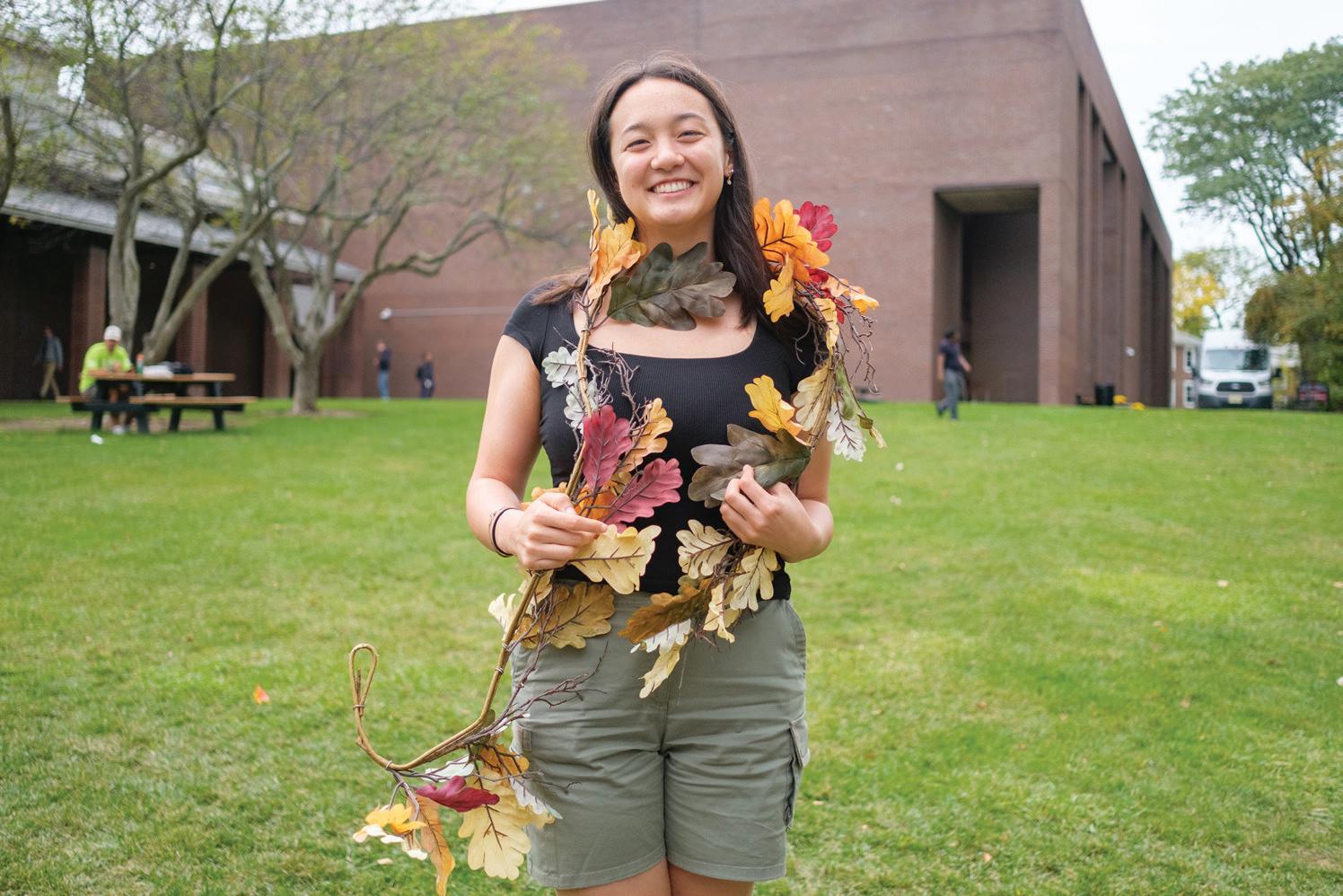
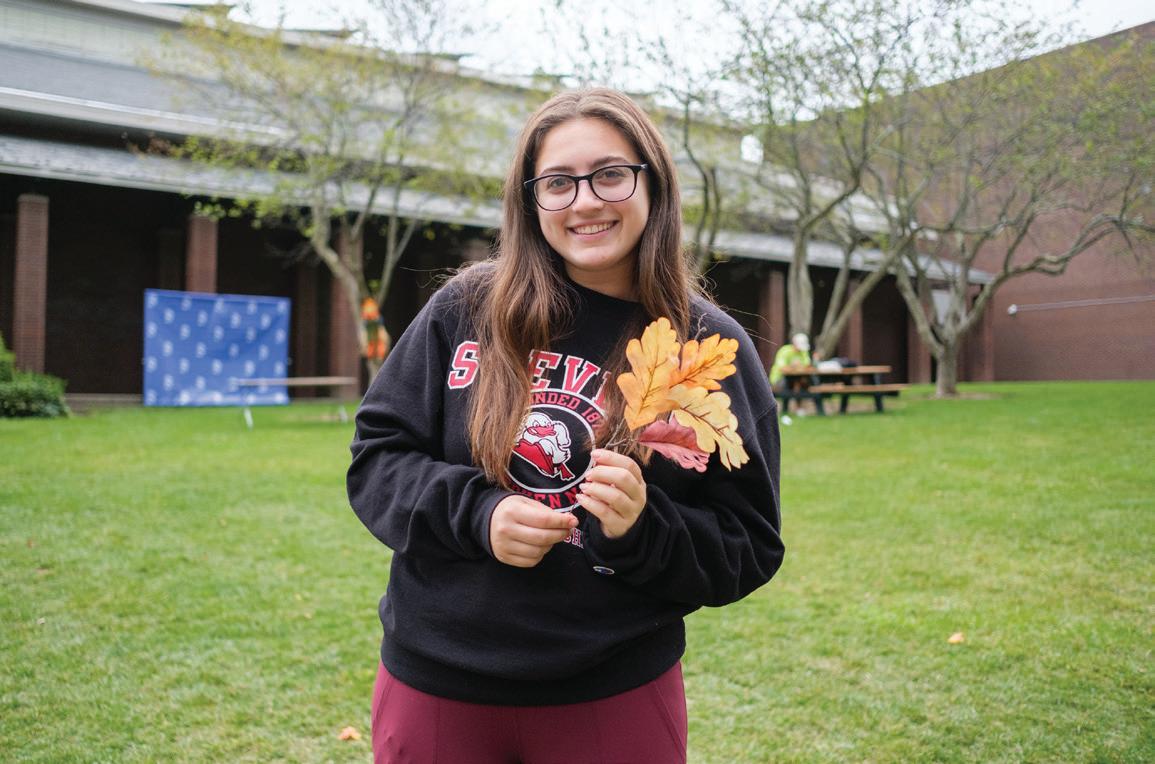
So as you sip on your favorite fall drink and take in the beauty of the season, just remember: “it’s the season of the sticks” and it’s meant to be admired.
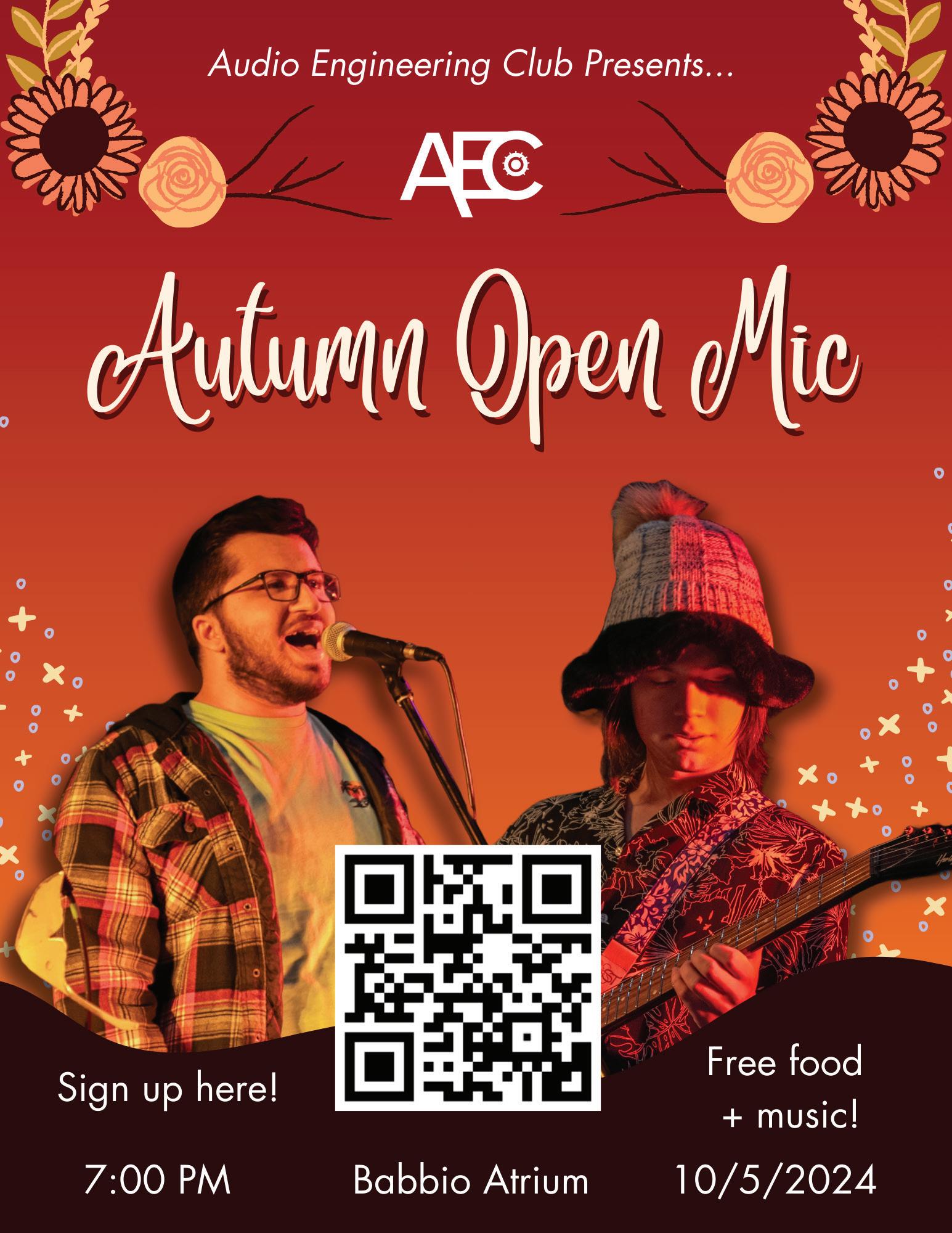
in cozy sweaters, sipping on apple cider and watching the leaves turn. She also can’t get enough of that satisfying crunch of leaves beneath her feet as she walks through cam pus. When it comes to the holi days, she has a strong attachment to all of them, but Halloween and her birthday take the top spots.
Our Editor-in-Chief admitted her fondness of Halloween-themed episodes and movies that add to the autumn charm.
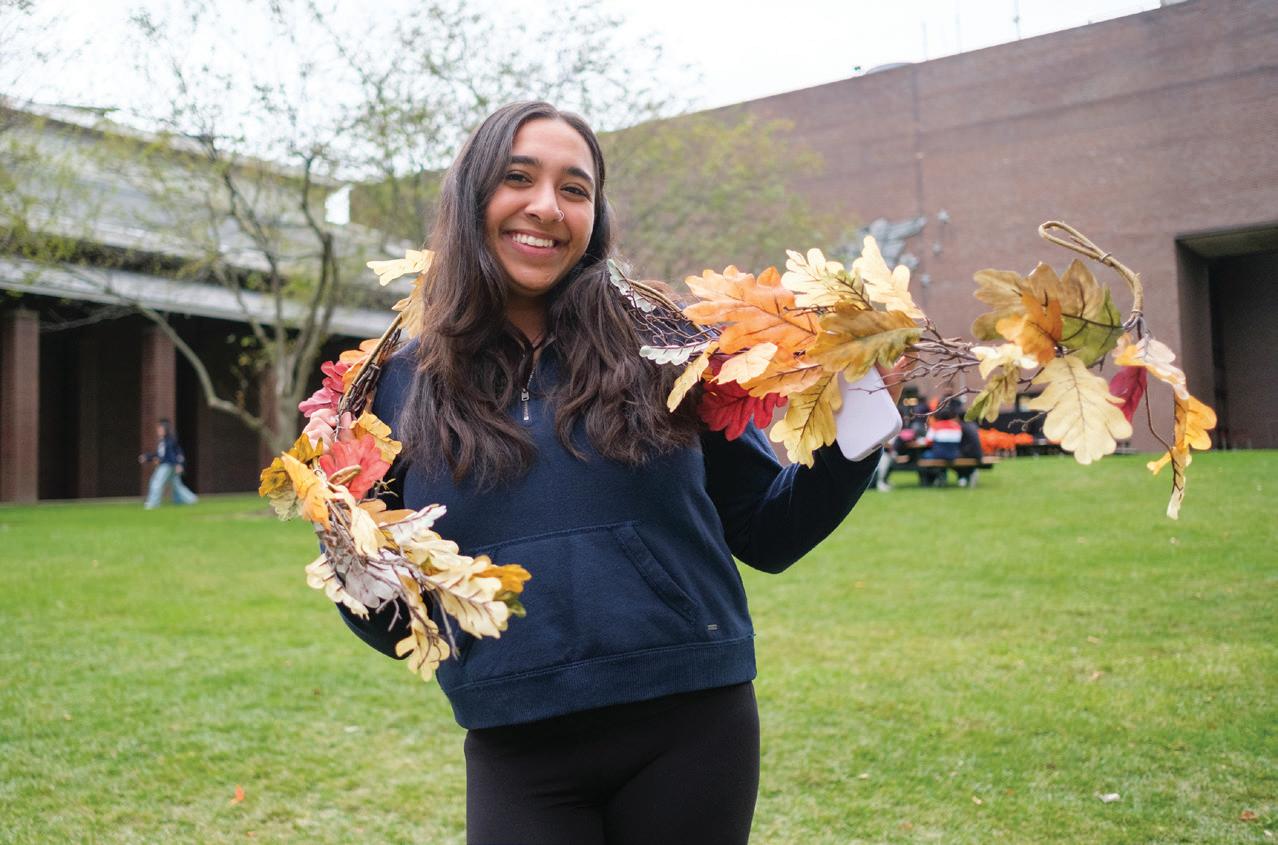
rying a latte and watching dogs with sweaters pass her by on the street. She soaks in every minute of the season before it leaves us.
Tanya Avadia Business Manager
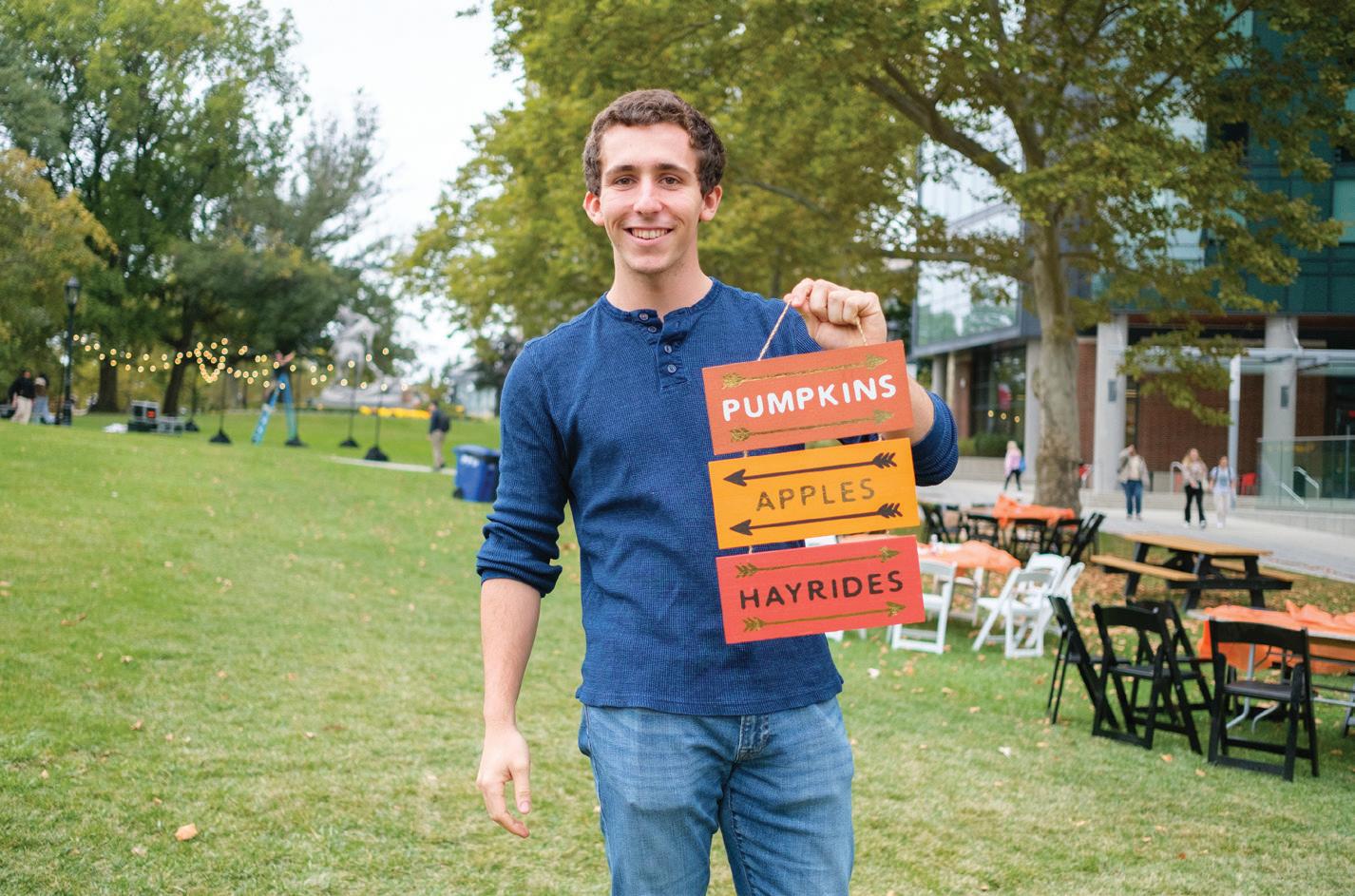
headphones in listening to any Noah Kahn or Gracie Abrams song with a pumpkin spice latte to warm me up from the crisp, cold breeze. Fall is my excuse to wear a fuzzy blanket and warm up next to a fireplace with a book or a good horror movie.
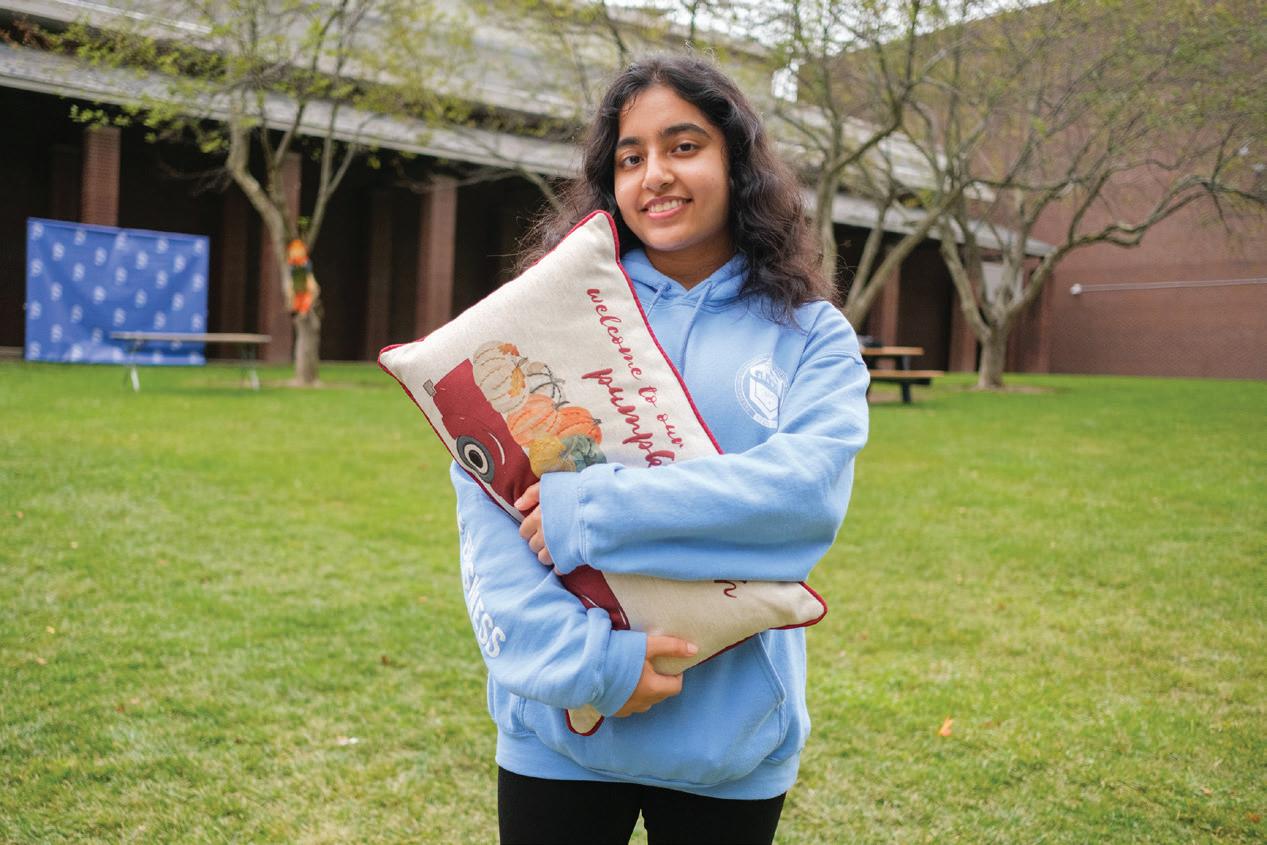
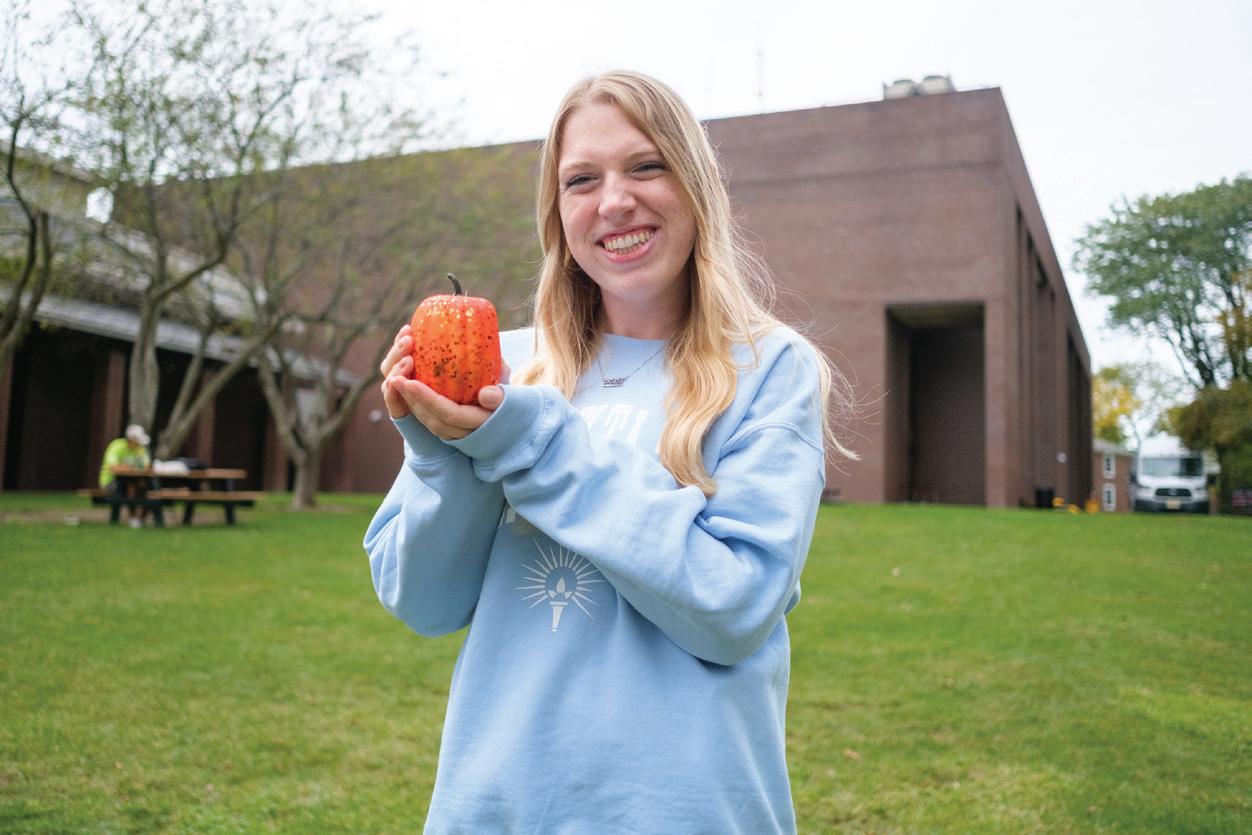
and fun. Beyond that, she savors the excitement surrounding the holidays. The family gatherings, celebrations, and traditions are what make it a season she truly
Evan Papageorge
for him, and he feels inspired and excited at the new begin nings ahead. He also admires the beauty that fall presents through the vibrant colors and changing of leaves.
and
make for a perfect fall day.
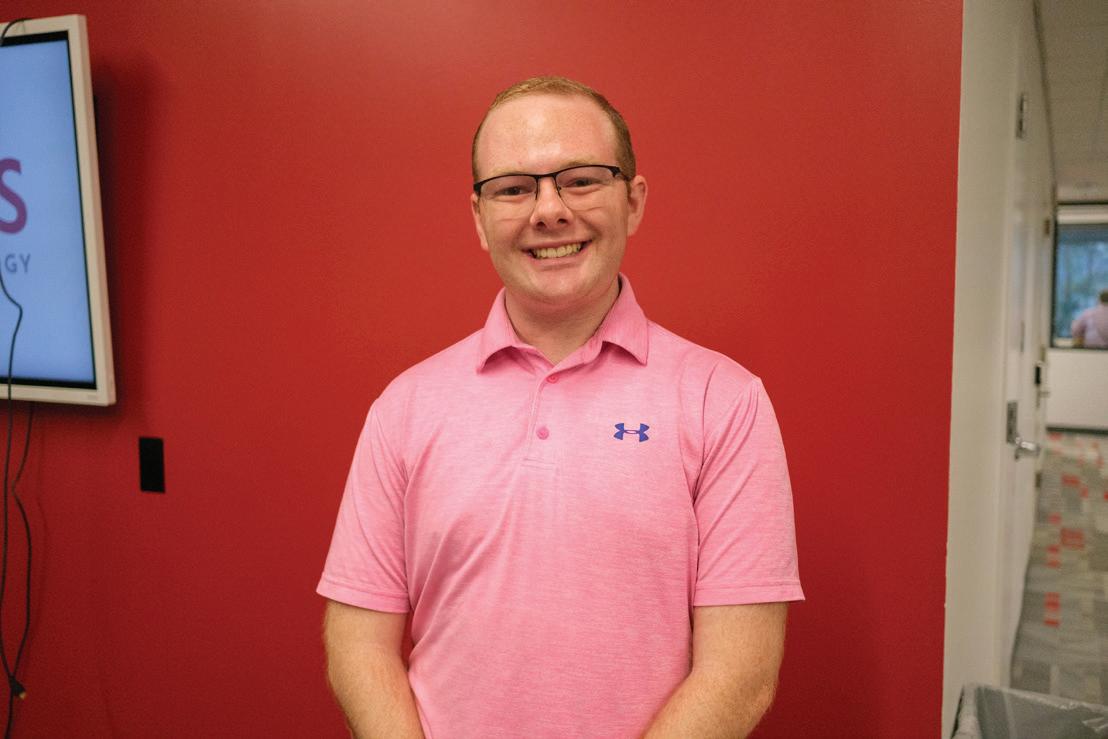
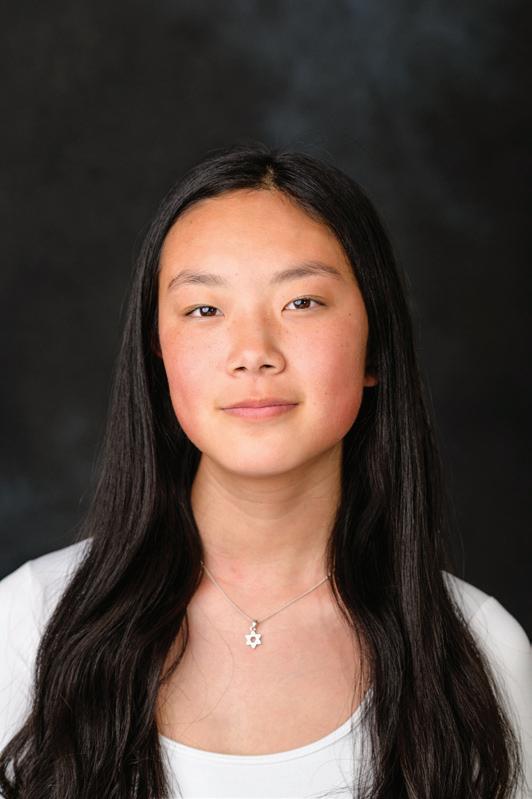
Arthur Serra
Jiya Jaisinghani
weather and the vibes.” If you know anything about Abby, this response just fits.
Nicole Giardino
lor Swift, Stick Season by Noah Kahan, and The Dream Chapter: Eternity by TXT. With a chai latte in hand, the perfect fall melodies
gorgeous scenery
Mathematicians discover a new class of shapes
BY ERIN MCGEE, SCIENCE WRITER
Mathematicians love tiling, the process of covering a surface using some set of geometric shapes with no gaps and overlaps. Tiling or tessellations can be seen in everything from art, to architecture, to even nature. The repeating hexagon in a bees honeycomb, an ancient Roman mosaic, and even the tiles in your bathroom, are all examples of a repeated shape that completely covers the plane.
A great deal of research in math has been on periodic and aperiodic tilings: patterns of shapes that repeat and do not repeat, respectively. A famous example is Penrose tiling, a class of shapes that do not repeat, but can have rotational and reflection symmetry. Just last year, researchers developed a shape called an ‘einstein’ or an aperiodic monotile, a shape that tiles the entire plane, but never repeats. This research into tiling has continued, with a new discovery very recently.
Researchers at the University
of Oxford and Budapest University of Technology and Economics have recently described an entirely new class of shapes: soft cells. These shapes have a soft number of edges that are smooth, with two cusp corners that add sides to the shape. The corners meet at kind of a ‘teardrop’ shape, and are rounded on the sides, with the sum of the interior angles being zero and can fit snugly together in a tiling pattern. In order to create this different class of shapes, researchers created an algorithm that took conventional geometric tiles, like polygons, and converted them into soft shells. This also led to them developing a measure of how ‘soft’ her shapes are, or how rounded the edges are. These shapes can even be converted into 3D tilings, which is done by taking a 3D shape and converting it into a soft shell with two cusps. Since the discovery, these shapes can be seen everywhere.
The nautilus shell, already famous in math for using the Fibonacci sequence, has also been found to
have a 3D soft shell shape in part of its segment. Soft shells can also be seen in the way onion layers form, or in the way rivers seem to braid around land. It can be found in architecture. For example, the Heydar Aliyev Center in Baku, Azerbaijan, uses cusps to minimize corners. Soft shells also appear in biological tissue, which adds new insights into biology and geometry research.
Further research will look more into the ‘softness’ factor of the shape, with mathematicians predicting that for a given tiling, there is a unique shape with the greatest possible softness. Researchers will also look for materials that utilize this tiling, with the hope of illuminating how these shapes can affect measures such as bending or tension. This new insight into nature provides researchers with an interesting connection between several different fields, and as Alain Goriely, a professor at the University of Oxford who worked on the project, put it: “Nature not only abhors a vacuum but she also seems to abhor sharp corners.”
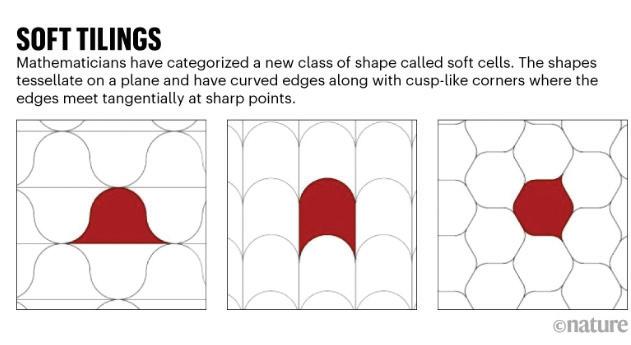
Unraveling men’s minds
BY SEAN ANDERSON, SCIENCE EDITOR
It has been jokingly said that “men are from Mars and women are from Venus.” Often, this is due to the notion that men and women think very differently. When analyzing male and female brains, there are often many similar areas that can be seen and neural activities that can be observed, but differences do also exist. According to Northwestern Medicine, “the male brain is 10 percent larger than the female brain,” but this difference has no effect on intelligence. Additionally, it has been discovered that the female brain contains more gray matter — which helps the body process information in the brain - but men tend to use more gray matter while women tend to use more white matterwhich connects processing centers. An important job of the brain is to control hormonal cycles, and for females, these hormonal changes will occur across a monthly cycle. For men, however, a different cycle frequency has been observed.
A recent study has shown that men have a daily hormonal cycle that is linked to activity in their brains. The study was conducted at the University of California, Santa Barbara (UCSB) and involved scanning a 26-year-old caucasian male’s brain multiple times over a period of a month. It is described
in the report of the study, published in the Journal of Neuroscience, that every 12-24 hours, the subject would go through a session where he “completed a questionnaire to assess stress, sleep, and mood states, followed by endocrine sampling at 7 a.m. (morning sessions) and/or at 8 p.m. (evening sessions).” Endocrine sampling will be used to determine hormone levels in the body at different times of the day. Additionally, a whole brain structural MRI was done to determine changes in head motion, but the report stated that there was “no significant difference between morning and evening sessions.” Whole-brain morphology assessments were also performed to test the gray matter volume, white matter volume, and cortical thickness of the participant’s brain.
The results of the tests showed a significant change in the brain from morning to night. In the morning, total brain volume and gray matter volume were at their peak but would be lower in the evening. With this, it was reported that these two values shared a positive correlation with steroid hormone concentrations, which include testosterone, estradiol, and cortisol. Cortical thickness shared a positive correlation as well with these values.
In analyzing the results, the researchers noted, “While it is clear
that brain morphology exhibits circadian change, the role of steroid hormones in shaping diurnal changes in brain volume is not definitive, as results from the present study are correlational.” No significant relationships between the two could be determined when their correlations were restricted. While nothing may be conclusive, these results indicate that there may be more to look into regarding the cyclic change of brain volume from day to night, which may have an effect on changes in behavior.
Live Science, who talked with the researchers and the participants of the study, notes how those involved with the study were driven by the goal to uncover more about a cycle that is more understood but not as much with men.
Elle Murata, a doctoral student in psychology and brain sciences at UCSB and one of the researchers in this study, stated, “this is, I think, another example debunking the myth that hormones are only relevant for females.” Pavel Shapturenka, the subject of the study, added a similar comment, addressing how much of the information out there highlights the hormonal invariability of females, but he appreciates how the study now brings light to how men’s endocrine systems have invariability and a path to a better understanding of the brain function of men.
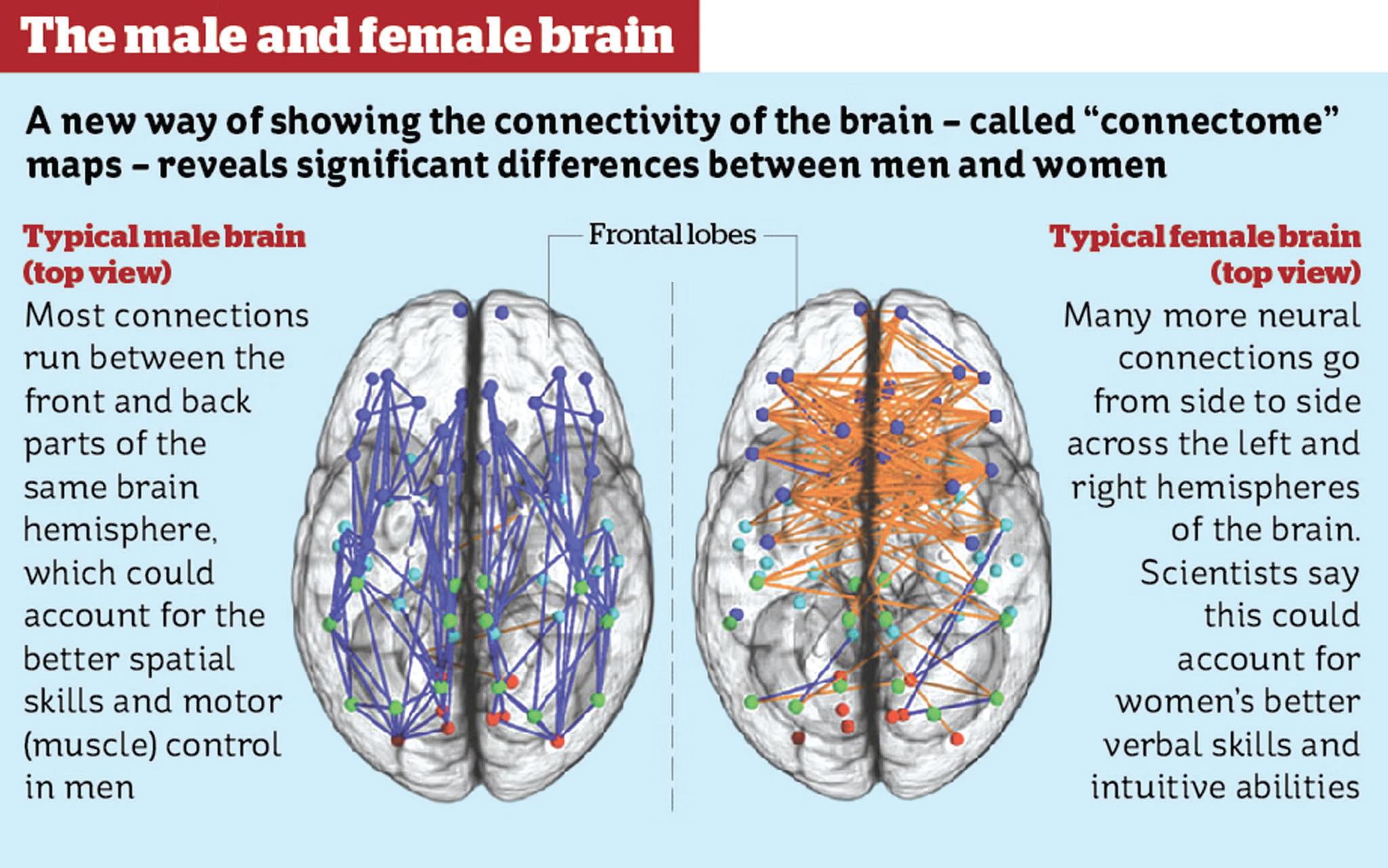
Picky eating is more genetic than you think

BY RIYANA PHADKE, SCIENCE EDITOR
It turns out that picky eaters may not be making a conscious choice after all: Their genes significantly influence their food preferences, according to a recent study published in the Journal of Child Psychology and Psychiatry. The research suggests that genetic factors play a much larger role in determining what foods people like or dislike than previously thought, meaning some individuals may be hardwired to be more selective about what they eat. Food fussiness, the term that will be used for this article, is the tendency to eat a small range of foods due to textures or taste preferences or reluctance to try new foods.
The study, which was funded by the UK mental health charity MQ Mental Health Research, compared survey results from parents with identical and nonidentical twins in England and Wales from 16 months to 13 years.
Researchers from University College London (UCL), King’s College London, and the University of Leeds noted that the average levels of food fussiness were relatively stable during this time frame, reaching maximum levels of pickiness around age seven and declining after that. The team concluded that genetic differences in the population resulted in a 60% variation in food fussiness at 16 months, increasing to more than 74% between the ages of 3 and 13.
Of course, genetics are not the only factor at play when discussing human habits. Environmental factors that the twins shared, such as types of food eaten at home, were found to be most significant in toddlerhood. Environmental factors that were individual to each twin, such as personal experiences, became more influential during later years.
Lead author Dr. Zeynep Nas, from UCL Behavioural Science & Health, said, “Food fussiness is common among children and can be a major source of anxiety for parents and caregivers, who often blame themselves for this behaviour [sic] or are blamed by others. We hope our finding that fussy eating is largely innate may help to alleviate parental blame. This behaviour is not a result of parenting”.
Senior author Professor Clare Llewellyn noted that genetic factors are the predominant influ-
ence for food fussiness, but there is some environmental role. She noted that since environmental factors seemed to only be prevalent in toddlerhood, it is likely that interventions to help children eat a wider variety of foods would be most effective in the very early years as compared to later.
Following their own study, the researchers analyzed data from the Gemina study, a UCL-led study on the largest twin cohort ever created to study the genetic and environmental contributions to early growth and development. This study involved 2,400 sets of twins, where parents filled out question-based surveys about their children’s eating habits at 16 months, three, five, seven, and thirteen years of age.
To determine the differences between genetics and environmental influences, researchers compared the fussy eating habits of non-identical twin pairs. Non-identical twins only share 50% of their genes, whereas identical twins share 100%. They found that non-identical twins had less similarities in their pickiness as compared to identical twins, demonstrating a large genetic influence in food fussiness.
Overall, unique environmental factors accounted for a quarter of individual differences between children between ages seven and thirteen, whereas shared environmental factors made up a quarter of individual differences in children at 16 months but then were negligible in later years.
Senior author Dr Alison Fildes from the University of Leeds noted that “Although fussy eating has a strong genetic component and can extend beyond early childhood, this doesn’t mean it is fixed. Parents can continue to support their children to eat a wide variety of foods throughout childhood and into adolescence, but peers and friends might become a more important influence on children’s diets as they reach their teens.”
Researchers determined that there were some limitations to their studies findings, stating that there were different numbers of participants at different time points and that the study’s sample had a large caucasian population from British households of higher socioeconomic status.
In the future, their research will focus on non-western populations where food culture, parental feeding practices, and food security may be vastly different.
PHOTO COURTESY OF DOMOKOS, G., GORIELY, A., HORVÁTH, A. G. & REGŐS, K.
PHOTO COURTESY
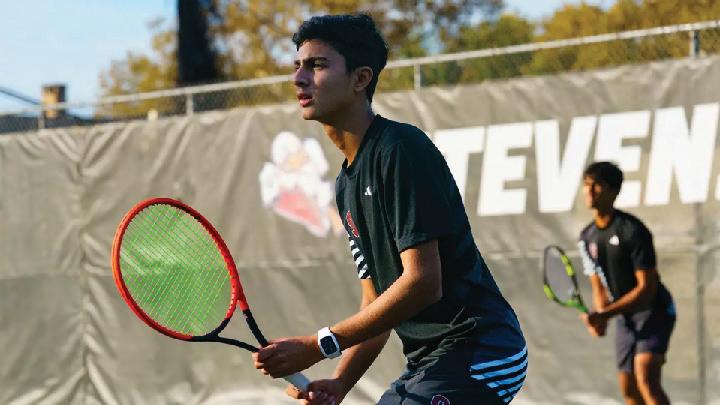
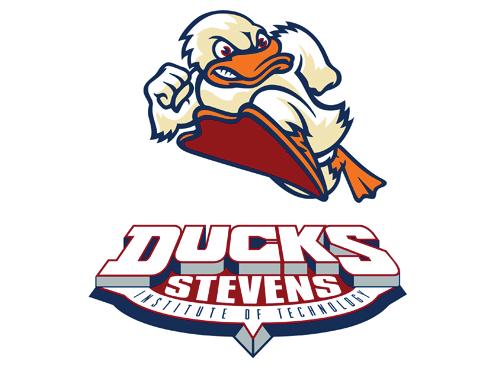
WOMEN’S
Stevens Tennis closes out Fall season at the ITA Regional
BY RIYANA PHADKE SCIENCE EDITOR
Over the last two weeks, the Stevens’ Men’s and Women’s Tennis teams have been battling it out on the courts, coming away with impressive results to close out the 2024 fall season. This year, the Ducks traveled to Fredericksburg, VA, for the three-day ITA Atlantic South Regional Championships.
The Men’s team had a rocky end to their fall season this past weekend from September 27 through 29. In the Championship Flight, junior Max-William Kanz came to play with an 8-7(8-6) victory over Christopher Newport University in the Round of 64 match. Unfortunately, he fell to Carnegie Mellon University in the Round of 32 match. In the Championship Doubles round, Kanz and second-year Samvid Andhare took a decisive victory over Wilkes University before an unfortunate setback from Swarthmore College. After entering as the ninth-ranked seed and
earning a bye into the Round of 32 match, seniors Vivek Harinarayan and Olof Persson faced a hard defeat against Salisbury University. First-years Mihir Parcha and Aidan Miller fell 6-2 to Carnegie Mellon in their opening round on Friday. Competing in the Blue 2 Flight on Saturday, Andhare advanced to the semifinal round after knocking out Shine Tokas of Shenandoah University and Braden Chavez of Carnegie Mellon. His run came to a close after being defeated by Albert Vladimirskiy from Mary Washington University. Mihir Parcha made an impressive rookie run in the Blue 1 Flight as he made his way to the semifinals after besting Salisbury University. In doubles, the Mens’ team fought hard in the Championship Consolation and Blue 1 flights, but were taken out in the first couple rounds. The Women’s team definitely came to play on September 20, with junior Sude Aytekin winning her opening match in the Champion-
ship Flight. She took a strong victory over Virginia Wesleyan’s Tuva Fink with a final score of 6-0.6-1. Unfortunately, Aytekin’s run ended after a 6- 0, 6- 2 loss to Carnegie Mellon’s Divya Venkatarama. Second-year Alix Dry also fought hard in the Championship Flight but fell short in her opening match against the ninth-ranked seed Grace Lorenz from Washington and Lee University.
In the Blue 1 Flight, junior Emma Eguia fell to Johns Hopkins’ Sahana Sanjeev with a final 6-0, 6-0 score. Second-year Julianna Gomez pushed hard against Swarthmore but was bested with a 6-2,6-4 score. In the Blue 2 Flight, first-year Wei-Wei Lai bowed out after her loss against Madeline Posner from Swarthmore. In the Blue 3 Flight, first-year Milagros Carbajal Diaz earned a decisive score against Randolph College in the Round of 16. Sadly, Diaz was outlasted in the quarterfinal with a final score of 6-3, 7-6 (10-8).
The Lady Ducks had two dou-
bles teams compete in the Championship Flight. Dry and third-year Stephanie Untermeyer earned a bye for the first round and were ranked ninth in the competition. The pair took down Haverford’s doubles team 8-4. Duo Aytekin and Diaz fell 8-2 to Washington College.
On Sunday, September 22, the women’s team took to the courts and closed out the ITA competition with happy news. Sophomores Lorena Piegas and Julianna Gomez won the Blue Flight Championships, beginning with their 8-1 victory over Virginia Wesleyan and battling their way through Washington College and Salisbury College. Dry and Untermeyer set a program record as they became the first Stevens duo to advance to the Round of 16 at the Atlantic South Regionals.
Head Coach Arik Zeevy noted, “We were fortunate to travel with eight players, all of whom gained valuable experience that will make us a stronger team in the Spring.”
Field Hockey takes one win and one loss in Virginia
BY CAMRYN WINANT, SPORTS WRITER
On September 28 and 29, Stevens Field Hockey traveled to Virginia to compete against Washington and Lee University and Roanoke College. They went up against Washington and Lee first on Saturday and faced a loss by one point after going into overtime. The next day, they redeemed themselves against Roanoke and won by two points.
The game against Washington and Lee had started slow, with zero shots being put in the goal in the first 30 minutes, even with six shots being made on the goal by the Ducks. The game picked up in the second half, with two shots being made by the Ducks early on in the third quarter. Less than 30 seconds in, sophomore Jess Kopernick
scored the first goal of the game and her second goal of the season. Less than two minutes later, senior Sarah Korczukowski scored a second goal with an assist from sophomore Kylee Scherer, who added to their lead. After Korczukowski’s goal, junior goalkeeper Lily Wierzbicki kept four shots out of goal until the Generals scored, halving the Ducks’ lead. The Ducks held that lead by keeping Washington and Lee without a shot for almost ten minutes during the final quarter, but the Generals notched a second goal against the Ducks, sending the game into overtime. Eight minutes into overtime, the Generals scored the game-winning goal, ending the game with a score of 3-2, with a loss for Stevens. Despite the loss, Wierzbicki made twelve saves in goal, three more than any game this season, and matched her ca-
reer high set on November 8, 2023, against Cortland University. Just like on Saturday, Kopernick scored the first goal of the game six minutes into the second quarter, with zero goals being made in the first quarter. In the first half of the game, the Maroons had only made one attempted shot on goal, and it was stopped by Wierzbicki. In the third period, the Ducks doubled their lead with a goal by Scherer off an assist by sophomore Lauren Flynn, marking Scherer’s first goal of the season. Through the rest of the third quarter, the Ducks held the Maroons shotless while attempting six shots on goal. With five minutes left in the final quarter, Roanoke upset the team’s shutout attempt with a goal off a penalty corner. Despite having a player down, the Ducks scored the winning goal with a shot by junior
Elizabeth Sullivan, who was making her season debut, off a feed from Korczukowski. They ended the game with a score of 3-1, with a win for Stevens. Along with the win, Stevens held their opponent to less than four shots on goal for the fourth time this season, held a 9-2 advantage on penalty corners, and made 18 on-target attempts, their third-most of the season.
On the win, head coach Meredith Spencer-Blaetz said, “Today was a full team win! We set up our game plan as a team and executed in a way that will continue to set us up for success moving forward. It was great to get some new goal scorers on the stat sheet as we head into the last few non-conference games.” The Ducks will be seen again back at Hoboken for Senior Day on October 5 against William Paterson University at 11 a.m.
STEVENS SCOREBOARD
WOMEN’S AND MEN’S FENCING US Fencing North American Cup Atlantic City, NJ Time TBD
WOMEN’S AND MEN’S CROSS COUNTRY Paul Short Run Bethlehem, PA 11:45/ 9:30 a.m.
Highlander Invitational Langhorne, PA 10/11 a.m.
WOMEN’S AND MEN’S SWIMMING
Montclair State University Hoboken, NJ 12 p.m.
WOMEN’S AND MEN’S SOCCER FDU-Florham Hoboken, NJ 2 p.m./5 p.m.
SUN OCT 6
WOMEN’S AND MEN’S FENCING US Fencing North American Cup Atlantic City, NJ Time TBD
MON OCT 7
WOMEN’S AND MEN’S FENCING US Fencing North American Cup Atlantic City, NJ Time TBD
MEN’S GOLF West Pines Collegiate–Day One Douglasville, GA Time TBA
TUE OCT 8
MEN’S GOLF West Pines Collegiate–Day Two Douglasville, GA Time TBA
MIND OF A FRESHMAN
The reason why they made the sidewalk is because some people aren’t meant for the streets
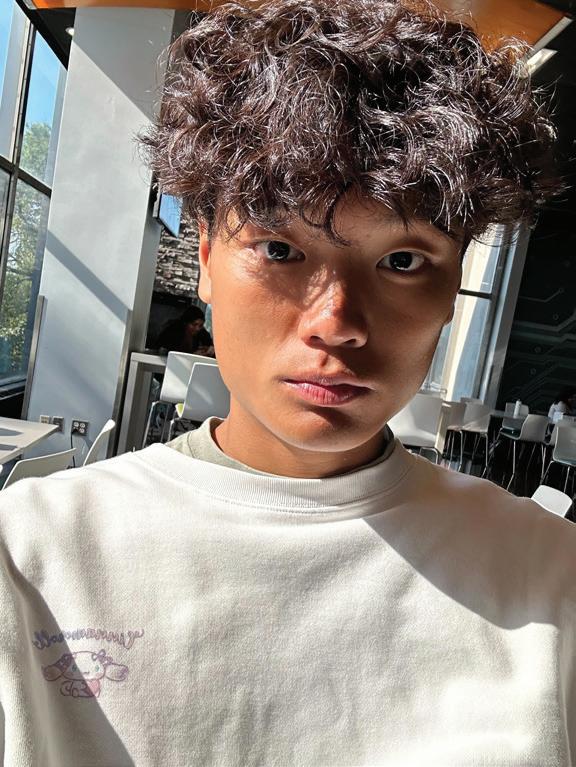
with a college-educated par ent, a big part of my upbringing was preparing for college. Or, at the very least, instilling the idea that a successful life starts with a four-year college degree and any other degree after that. So evidently, the first 18 years of my life were lived with the purpose of studying to get into a good college. However, life happened. When I was a youngin’,
FOODIE FINDS
my idea of success was getting into an Ivy League and then buying a big house with a golden toilet. Specifically, the golden toilet was my idea of success for some odd reason. After experiencing life for 18 long years and going through experiences that have allowed me to mature, my idea of success has changed from a golden toilet to a more modest life. Now, my idea of success is financial freedom. To me financial freedom is the ability to live my life, to be able to do what I want without looking at my bank account. I want to own an animal with short legs. Perhaps a raccoon, a British shorthair cat, a chinchilla, who knows. THIS BEING SAID, going back to experiencing life and maturing, college has been a sobering experience (metaphorically, of course).
I always imagined college to be a grand time with partying, drinking, and every
A trip down flavor lane

BY PRISHA VAGVALA ‘28
Would you trade a couple of duckbills for a taste of something heavenly? Well, I did when I ordered Bluestone Lane Café’s strawberry matcha coconut cloud drink. The vegan matcha cold foam’s earthy flavors and notes of sweetness paired with the strawberry base’s fruity punch were incredibly divine. As someone who usually drinks slowly, let me tell you, this drink was so addicting I finished it in under ten minutes. Besides this one stellar drink, Bluestone Lane’s menu has a vibe of its own, from their Bondi Blue Smoothie that resembles a dark clouded sky to their Blue Lavender Matcha Cloud, which is dairy-free. This Melbourne-inspired café is nestled in a charming blue shop and offers ethically sourced and sustainably packaged coffee. Sure, the drinks are a bit on the pricey side, but for the quality, quantity, and good practices, it’s worth it. On my second visit, I had to try the Aussie Iced Chocolate, and trust me when I say it was the bomb. It was a chocoholic’s dream, with velvety, decadent chocolate blended perfectly with a subtle hint of rich espresso flavor, adding just the right contrast.
Bluestone Lane’s calming aura is due to its cozy, spacious seating and nautical color scheme. They even have an outdoor space under an adorable blue tent, carrying the recurring theme onto Hoboken’s streets. With both indoor and outdoor seating options, it’s perfect year-round. But let’s also talk about the service — the staff were super friendly. On my first visit, the barista shared stories of how a group of students ran into their professor while doing their homework for that professor before class in their cafe. The conversational staff creates a welcoming atmosphere, encapsulating the true Australian spirit! The real magic of Bluestone lies in how quick
other fun thing you can think of, and for the first two weeks of school, it was exactly that. Going out to parties, clubbing, and doing a bunch of other things my parents probably wouldn’t approve of. Life was great until the inevitable happened. I came down with frat flu. While I wasn’t unprepared for sickness, it didn’t make the experience any better, unfortunately. I recovered after about a week of suffering. However, something I noticed is that everyone got sick. It is a little more comforting knowing that I wasn’t the only one suffering. Hearing the collective sniffle and the patented death cough made the experience of dying in bed a little better. As many would call it, the freshman class catching frat flu is a “canon” experience every year. Some could even go as far as to call it the most tame hazing for the inauguration of the freshman class into the school. While
GIRL-ISH TALK
the service is. I had just ordered when they called out, “One Aussie Iced Chocolate for Prisha.” I was astounded! I’m sure the guy who made my drink had some superpower because I have never seen such quick service. Even when I ordered my strawberry matcha coconut cloud during rush hour, I still received my order in just seven minutes. Their Google Reviews rave about the customer service, and while there are a few complaints about the price, Bluestone Lane doesn’t shy away from addressing them instantly. Their quick and polite replies to reviews show their dedication to customer satisfaction. Not only is it a café but also a brunch spot, offering a variety of healthy and delicious options, like the soft chili scramble with avocado or the breakfast bowl under the menu titled “brekkie originals,” which is Aussie slang for breakfast. The pancake and sweets menu is to die for! They have some of the most mouthwatering options — imagine fresh lemon ricotta pancakes topped with fluffy ricotta, sour and creamy citrus curd, and tart raspberries. Absolutely, utterly scrumptious! Don’t even get me started on the gluten-free banana bread served with whipped ricotta, fresh berries, and roasted pecans drizzled with locally sourced honey. Another nice touch is how they mention each menu item’s food restrictions, like soy, dairy, gluten, and eggs, along with the calorie count, making it easier for those with food allergies. It’s safe to say that Bluestone Lane has become my reliable go-to café, and I’m happy to pay the price if it means supporting a shop that promotes ethically sourced coffee. They partner with coffee farmers in Africa, Asia, and South America and are involved in every step of the sourcing process. It’s rare to find a place so well-rounded in customer service, sustainability, and ethical practices, which is why this café resonates with me more than many others. Its menu is inclusive and healthy, offering vegan and non-dairy options while bringing that authentic Australian touch. Next time I visit, my friend has convinced me to try Vegemite, and for Bluestone Lane, I just might — even though I dislike Vegemite.
my era of sickness is coming to an end, I know some are just starting; thug it out. As every Mind of a Freshman article up until now has been me crashing out about something, it feels only right to continue that tradition. It pains me to admit that on my very valuable Saturday, I spent around nine hours doing homework, mainly CS 115. While some would say, “Oh that’s great he’s being productive”, I would argue that it only took nine hours due to my own incompetence and inexperience in coding. I would like to point out that my incompetence at recursion and Python is not due to any lack of effort on Profesor Zumrut. If anything, I actually love Prof. Zumrut’s class, and it is a high point any day I have the class. HOWEVER, that factor did not lessen my suffering by any amount. After a long and tumultuous amount of time slaving away at writing code,
If loving fall is basic, so be it; I’ll be basic
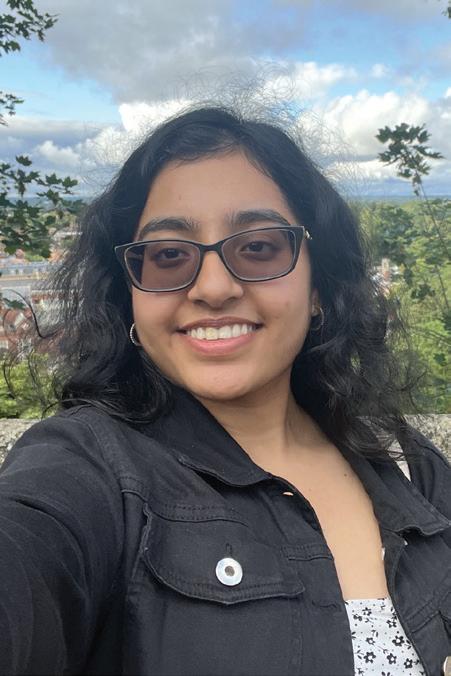
BY TANYA AVADIA ‘26
My favorite time of year is here! I absolutely love it when the weather starts getting colder. I can start drinking hot teas and drinks, layer my outfits and incorporate sweaters and jackets into my fits, walk in the rain, and watch the fall foliage. On a deeper level, I also look forward to the feeling of new beginnings and the anticipation of the holiday season. While I know many may not be looking forward to the transition from a hot summer to a cold winter, I really love fall. I’m also aware that many others share my sentiment, having seen my “For You” page showcasing Tiktok after Tiktok of the girlies redecorating their houses, wearing cozy sweaters, and drinking pumpkin spice lattes and honestly, I’m here for it! However, something that needs to be addressed is how there is this notion that if girls or women are into something collectively, they are “basic.” And it appears that loving autumn is no exception to this. If loving this season is basic, so be it; I’ll be basic.
The word “basic” in slang refers to being unoriginal and mainstream. When you think of a basic girl, you typically imagine a girl who loves her pumpkin spice lattes, wears UGGs, and is carrying around her Stanley cup while listening to Taylor Swift. My question is, why is doing/enjoying all of these things wrong? All of these characteristics come from trends or what is popular at the moment. Every fall, people are so excited to get pumpkin spice drinks. UGGs, while expensive, are comfortable and cozy shoes. Before Stanleys, everyone used to have a hydro flask. Lastly, Taylor Swift is one of the most popular artists worldwide. If you enjoy something that is trendy and popular or you engage with something that is mainstream, that isn’t necessarily a bad thing.
From a psychological
I had finished and started to wonder the question that every tech major asks themself. Why did I choose this freaking major? I have no prior experience in coding. I think math is all right; I’m not a whizz at computers. Seeing how it looks right now, I am not built for these streets. I remember when I told my mom about my major; my mother told me that cybersecurity was not an easy major and that a lot of people give up and transfer their major. When she told me this, I scoffed and told her not to worry. So in the interest of preserving my pride, I am determined that if I do not succeed in this field, it will not be from a lack of effort on my part. As the Koreans say on their variety shows, “fighting” *fist pump*.
As I am sure many people have noticed, especially if they use Gradarius, there is a paywall now for doing homework. LIKE I BARELY WANT
TO DO HOMEWORK ALREADY, so which Ph.D professor’s idea was it to charge students around 20 dollars to do CALCULUS HOMEWORK ON AN ALREADY FRUSTRATING PROGRAM? What ever happened to uploading a nice calm worksheet where I can do work with a pencil? Instead, now I need to deal with Gradarius giving me a big red EXCLAMATION MARK when I try to say that the derivative of x^2 is 2x. Like, please, man, do you know what I can get with 20 dollars? I can get so many snacks, or even a Chipotle bowl of guac and chicken AND A DRINK AND CHIPS. Instead, I’M SPENDING MY 20 DOLLARS ON QUITE POSSIBLY the most QUIRKY math program. Gradarius is like Desmos if Desmos was a pick me. Anyway, I’ve already gone over the word count, so until next time, I will use Toodles.
BOOK OF THE WEEK
Why you should read an essay collection
point of view, humans are conditioned to follow the societal norm. This stems from the fact that humans are social creatures and crave belonging. And with the new era of technology and entertainment via social media, a lot of people turn to their social media feeds to rely on how to best interact with and fit in with society. This is important to an extent because it keeps people informed and, in a way, provides a mental shortcut to what others are doing and how we can replicate it too to fulfill our need of societal acceptance. Again, this isn’t bad, so we are programmed to do it. My issue is that when girls and women engage with what is trendy and it becomes something that collectively a lot of girls like, it gets labeled as being “basic,” which is an insult.
I also wonder why it is that when girls share a common interest, it is so quickly labeled basic by society, but when boys share a common interest, it quite literally just remains a “guy thing.”
A lot of this unfortunately goes back to the gender norms instilled by society and how society typically pays no heed to the significance of female interests. Women historically have always been scrutinized for the way they present themselves and what they take interest in. For example, women weren’t allowed to discuss matters pertaining to politics or read educational literature. At the same time, when women did engage in conversations with each other about common interests, it quickly got labeled as “gossip,” and that stance alone made it seem that women only discussed trivial matters while men were the ones that held more intellectual conversations. The irony is that even if a woman wanted to state her opinion or share an intellectual fact in the past, she would get ridiculed, and her ideas would be dismissed.
Luckily, times have changed and people are free to take interest in whatever they want but those following the mainstream norms shouldn’t be scrutinized for their choices especially if on a gender basis. So to any girlie or really anyone reading this buy the pumpkin spice latte if you want to, listen to Taylor Swift if you enjoy her music, wear your UGGs and do whatever you enjoy because I certainly will.

BY MADISON HELLER ‘27
Nobody Knows My Name is an essay collection by James Baldwin that is phenomenal, and anyone even slightly interested should read it. Normally what I like to read is novels, and I stand by the fact that there is nothing better than curling up under covers with a good book. Until recently, I have rarely ventured out of that zone other than the occasional Pop non-fiction book. However, I can acknowledge the value found in essays and essay collections and have had that belief confirmed with my recent readings. This semester, I am taking a class on the writer and activist James Baldwin, and as a result, reading large swathes of essays and novels that he has written. I cannot say that I understand everything that he has said perfectly — reading something once will rarely get you there. But I think many people would benefit from reading this particular essay collection and pondering what he has to say.
Understanding that most people will never pick up a book just because someone told them it was worth it, I desire to explain what I took from Baldwin’s Essays. Their chief concern is with identity, what it is, and who defines what it is. He makes it clear that we cannot know anything about the world and its problems and their solutions until we know who we ourselves are. And that what we define ourselves as only exists in the context of other people that we have been surrounded by since birth. His own context for this exists in the civil rights era — before anything else, Baldwin knew that in America, he would be seen as a black writer before he would be seen as a writer. It is for that very reason he moved to Paris for a while. The essay collection is from the time he spent in France, and the distance from American society allows him to comment candidly on it. It is his realization in Paris that the only reason he
was not discriminated against there was that he was seen as an American writer before being a writer. It became crucial to him that you cannot lump experiences together under one name, one house when every individual and every perspective by default is going to differ radically. How individuals define their own experiences still ultimately relates to other people. There is simply no other way of going about it — my experience was bad because it was worse compared to yours, and so on. In one particular essay, Princes and Powers, Baldwin extrapolates his claims on identity by showcasing how being lumped together by appearance does not guarantee a shared identity. During his time, there was a Pan-African movement, where black people from around the globe were called to share an identity of being similar because some hundreds of years ago, they hailed from the same place. This ultimately failed because, as Baldwin points out, there is no unifying experience between the parts of Africa that had been colonized, the black Americans, black Europeans, etc. All of them had experienced radically different forms of oppression and struggle, yes because of their blackness, but for different reasons and in different contexts, which led to very little unification on actual solutions or goals. Different people want and need different things, and even in a conference full of other black people, they were defining each other by their race and origin first and what they could contribute separately. Baldwin’s perspective was ultimately saying that it’s a complicated issue; there cannot be one shared international identity because there is no shared international issue. And he ended up being correct as that movement soon died out for those exact reasons. There is so much more than I alone can say and express, partly because I am not an expert and partly because there is just so much you can take from one essay of Baldwins, let alone an entire collection of them. However, the chief concern is identity, particularly his identity as a black man during the civil rights movement. I highly recommend that any curious individual read even one of his essays, as his way of writing holds any casual reader captive.
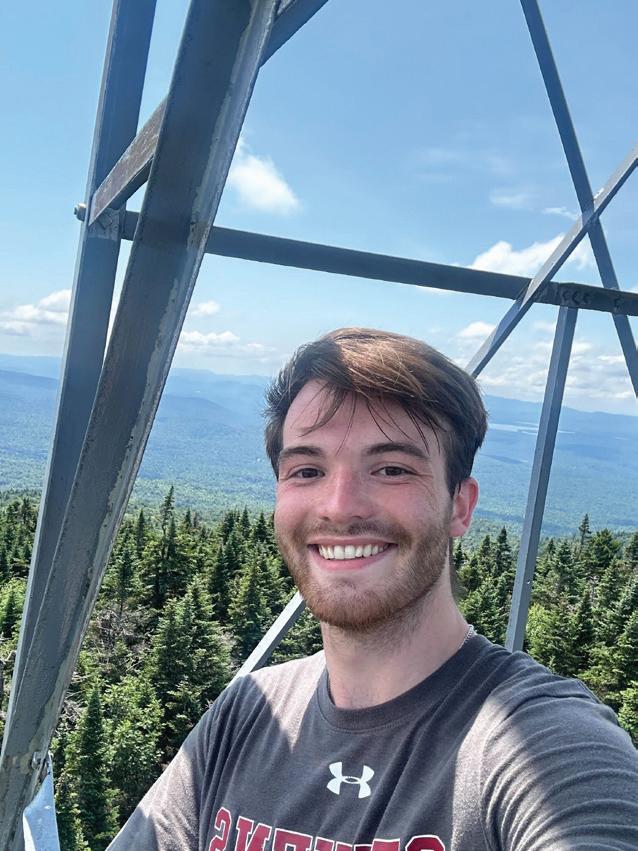
BAFFLING BITS & BOBS
ON SHUFFLE Brat on shuffle
BY KEVIN CASTNER JR. B.S. ‘24 & GRADUATE STUDENT
Alrighty folks, it’s time for my second most favorite season of the year: FALL. I said last time that I would be writing about bicycle gears this time around. I lied. After much thought and greatly appreciated input from Her Excellency Royal Highness Editor-in-Chief Isabella Ziv over some subpar Mexican cuisine in Pierce, I landed on zippers because of jackets and autumnal weather or something like that. With the epic backstory of this piece out of the way, let’s talk about the epic backstory of zippers. Firstly, the technical name for a zipper is a separable fastener. Patented by Gideon Sundback in 1917, not much has changed with the design today, but that does not mean there has been a lack of protection of intellectual property for the sake of corporate gree — pardon, innovation since then. Speaking of, the diagram I yoinked for this article because I was too lazy to model a zipper this week comes from a patent filed yesterday at the time of me writing this article, so probably a week from when you’re reading this. Nowadays, there is one company that is responsible for 50% of the world’s zippers and for saving us all from the tyranny of the button fly. In fact, I have coined a term for them. You know when you’re in the know? IYKYK? Well if you see a zipper just about anywhere chances are IYKK, i.e. It’s Yoshida Kōgyō Kabushikigaisha. Translating to Yoshida Manufacturing Corporation in English, YKK is a Japanese company based in Tokyo with manufacturing plants all over the world. As I mentioned earlier, although I was too lazy to model a zipper myself, it was not easy finding a technical drawing of a zipper that I liked either. I wanted to show a section view for easy understanding of the underlying principles. I first turned to my favorite things to search through: academic papers. Shockingly, I did find a great free-body diagram, but it was way too
FOR
MATH’S
grainy, even by the impeccable resolution standards that we here at The Stute abide by. I was then forced to search through my second favorite type of media for mindless perusing: U.S. patents. Let me tell ya, YKK has more patents related to fasteners than I thought was humanly possible, but the lovely diagram accompanying this article was made possible because of them, so another point on the board for The Man I suppose. I also found a patent for a cane that has an end shaped like a foot for “ergonomic purposes.”
Quite the hilarious read if you are interested. The patent numbers for the original zipper patent, the patent that supplied this article’s diagram, and the foot cane are as follows: US-1219881-A, US-20240315402-A1, and US-12096830-B2. Just look up U.S. patent search and you are ready to go. Back to the actual topic at hand! As a purely mechanical mechanism, zippers are also made out of simple machines. In fact, the zipper is just a bunch of wedges. Each of the tiny bits that get zipped together are called elements. The elements are just small wedges that get wedged together by the flanges on either side of the slider. The slider houses two key elements, the flanges and the diamond. As stated, as the slider is pulled up, the flanges wedge the elements together. When the slider is pulled down, the diamond wedges itself between the elements, wedging them apart. I don’t know if I have ever typed out “wedge” so many times in my life, and I am now in the mood for Doritos. Well, there you have it, a relatively simple, but exceedingly versatile compound machine, found everywhere from my jorts to the aerospace industry. Happy Autumn everybody, and make sure your fly isn’t down when you stunt out in your flyest of Fall fits.

GRAPHIC COURTESY OF U.S. PATENT & TRADEMARK OFFICE (PATENTED BY YKK CORPORATION)
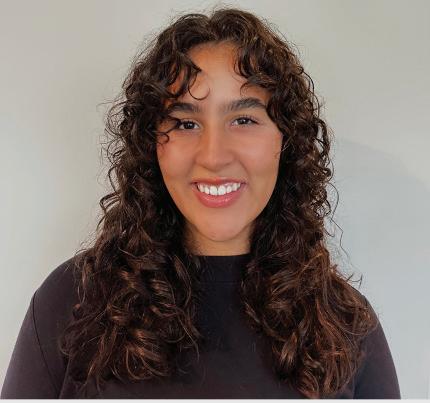
THOMAS ‘26
Did you have a Brat summer? Is your wardrobe all electric-green? Are you subtly obsessed with house music now? If you answered yes to at least one of these questions then you already know the UK-born, Indian-Scottish pop icon that is Charli XCX. Legally known as Charlotte Emma Aitchison, Charli XCX has taken the world by storm with her Party Girl raves and secret basement shows across the globe. She never ceases to amaze her audiences with stellar performances and bass drops that will echo in your soul. Her music career is not linear whatsoever, and her coming-to-stardom story is one for the books.
The year was 2010. Statement necklaces, social media challenges, and silly bands were all the rage. Pop culture was moving towards a slightly edgy, more relatable tone. Chari XCX had been picked up by a record company as she began releasing singles and mixtapes. Fast-for-
ward two years into 2012, she released her ground-breaking, record-smashing hit “I Love It.” Charli teamed up with Icona Pop, and this song became an international hit. If you think you don’t know this song, think again. Just think of the first song that comes to mind when you hear “I love it” in a British accent. Yup… it’s that song. Charli XCX has been working in the industry ever since then, pulling through with constant bangers. She opened for Taylor Swift on her “Reputation” tour back in 2018 (also… shoutout to Swifties! We all have been waiting for Taylor’s Version to drop). This type of exposure is what helped Charli gain a new following in the mainstream pop world. However, this moment was not too bright for Charli. She had gone into an interview with Pitchfork, explaining how she was grateful that Taylor had asked her to open, but she said she had “felt like [she] was getting up onstage and waving to 5-year-olds.” Fans were personally hurt and had taken to social media to express their disdain. Charli later apologized and decided never to go against the Swifties ever again. Flash forward to the summer heat of June 2024. The internet is boiling with mysterious posters plastered all over the globe’s biggest cities. From the flashing lights of NYC to the cosmopolitan capital of Barcelona, lime
UNMASKING: AN AUTISM STORY
green messages were shared. June calls for beach parties and that sweet feeling of freedom from college classes. It’s almost like Charli had known exactly what we needed. On June 7, 2024, her sixth studio album, Brat, debuted at number three on the Billboard 200, number two on the UK charts, and Top 10 in multiple different countries. This album is the perfect combination of Gen Z realness, cool-girl aesthetics, and “angsty teenage girl bedroom” vibes. Teaming up with her long-time friend and producer, A.G. Cook, and her partner, George Daniel, she released this star-studded piece of art. If the name George Daniel rings a bell, he is the drummer and producer of the alternative group The 1975. George Daniel and Charli XCX had run in the same circles for the longest time and decided to tie the knot with their recent engagement announcement. Both artists are extremely talented and impressive in their art. Charli and George are the epitome of “It Couple.” Charli is now on tour with the stylish, versatile, and trendsetting Troy Sivan. They are currently in North America spreading the word of the escapism in partying and yearning for true love in a sweaty basement. Troy and Charli are the perfect touring duo. Their playful songs, paired with strobe lights and alluring background dancers, will
be sure to give every audience the best concert experience. Their tour is called “The Sweat Tour,” which is very fitting because their music is sure to get your heart racing. I wish I could have been at their Madison Square Garden performance on Monday, September 23, but the school called, and I had to answer… typical Stevens student. Brat is packed with house music beats and experimental lyrics. She boasts about her coolness in songs like “360” and “Club Classics.” Combining hyperpop with dance and electropop is something only Charli could pursue. Her Tiktok viral, “Apple,” is a fun tune that subtly speaks on her issues with generational trauma inherited from her parents. Charli does this cool thing where she masks deep, emotional lyrics under her crazy electronic beats.
If you are going out on a Saturday night and you need something to get you excited, play Brat. This album is for all the people who skipped laundry day and slept in their makeup. If you wake up in your eyeliner or you greet the day with the outfit you wore the night before, you are very Brat. Giving your parents a hard time or spending more money than you have is the best way to fit into this subculture. Grab your neon green clothes, team up with your best friends, and fuel your next Saturday night with Charli XCX’s Brat.
Nostalgia — the trap and blessing of your memory
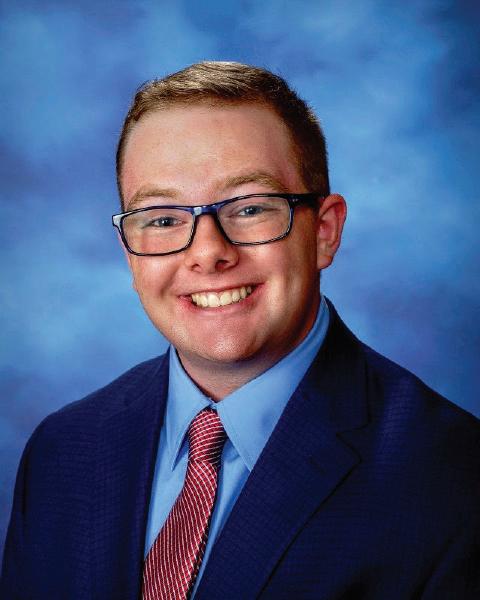
BY EVAN PAPAGEORGE
As the fall begins to turn the trees red, bring out the sweaters from deep in the closet, and unleash the pumpkin-apple-cidery monsters into the shops and bakeries, it is a time filled with nostalgia. Thinking back to the idealized first day of school back home, going on walks with leaves crunching below your shoes, thinking about upcoming holidays, and the bittersweetness of midterms (ugh) signaling that you are almost halfway through the semester (yikes!) However, for individuals with autism, nostalgia can be a tricky subject. What is the bal-
ance between having an excellent memory and experiencing little or hyperbole emotions? So, the question remains: what is nostalgia like for those with autism?
Nostalgia is the feeling or longing for the past. It is often a result of some sensory remembrance — seeing someone, hearing a song, smelling a unique smell, or tasting something you had as a child. Nostalgia is a profoundly personal experience, unique to each individual. It often is something happy, but it can also be a more negative feeling, like homesickness if someone is having a tough time and remembers when they were doing better or remembering something sad from their past.
Autism and nostalgia raise an interesting question. Individuals with autism, myself included, can have an excellent memory. However, autism can also cause either dampened or hyperboled emotions. Sometimes, I had to cancel my plans because I heard a song I remember from the bus to school in 3rd grade. Some
SAKE Busy beaver (the mathematical version)
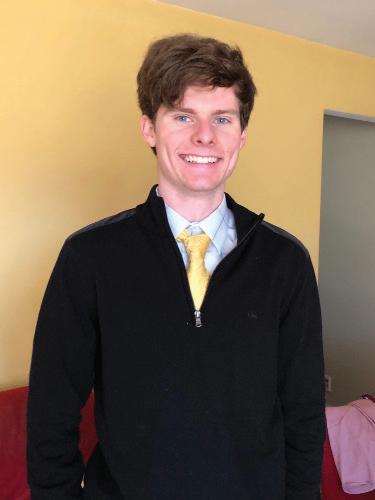
BY CHARLES BEALL B.S. ‘23 & PHD STUDENT
ics,” I respond to them with: doubters be dammed! I hope this article will silence the (admittedly justified) skeptics by summarizing a rather remarkable story of mathematical insight, adversity, and community, with flashes of programming savviness and homages to the largest rodent in North America. The story begins with the
founder of computer science, Alan Turing, and his famous idealized machines, which helped codify several key elements of the theory of computation. Turing machines are theoretical devices consisting of an infinitely long piece of tape that’s split into square cells. Each cell contains a zero or one, and the machine performs operations on these cells in accordance with a certain number of rules. Each application of a rule is called a “step.” Turing, with practical computation in mind, knew that it was important to determine whether a machine with a given set of rules would continue performing operations on the cells indefinitely or eventually halt, yielding some tangible outcome after a finite number of steps. In studying this halting problem, however, he realized that there is no systematic way to classify every machine as either halting or non-halting. In slightly more CS jargon, the halting problem is incomputable — there is no general
algorithm that can say, based on any inputted Turing machine and rulebook, whether or not that machine will halt.
In the 1960s, three decades after Turing’s seminal work, Tibor Radó, a Hungarian mathematician who escaped Siberian prison after his capture during World War I, trekked across the Russian Arctic and eventually landed a professorship in the U.S., decided to look at Turing machines from a different perspective. He lumped Turing machines into categories based on the number of rules each one has and noticed something interesting.
More precisely, there is a special combination of rules such that the Turing machine runs for six steps before halting. This number is greater than any other Turing machine with two rules that halts in finite time. As a result, he deemed this special machine the two-state busy beaver in honor of the animal’s industriousness in building dams.
This of course can be gen-
eralized to any number of states: we define the nth-state busy beaver as the Turing machine with n rules which runs for longer than any other halting machine with the same number of rules. The busy beaver number, denoted as BB(n), is the number of steps this longest-running machine takes. Because there’s no clear way of ruling out whether a machine halts though, the problem of finding the busy beaver and its associated number is extremely challenging. Allen Brady, a graduate of Oregon State University (whose mascot is the beaver), needed almost ten years to prove that BB(4) was equal to 107; part of his proof involved several calculations done via computers at a facility in Beaverton, Oregon. Recently, an online community of 20-plus contributors, many of whom without mathematics degrees, found BB(5) (which is 47,176,870), collaborating on Discord and utilizing software called Coq, which can verify the logic of mathematical proofs. The only
think, “oh, I remember this song from the bus!” individuals with autism often remember things more vividly (an easy way I explain it is I don’t have an inner monologue; I have a movie playing in my head) and be momentarily trapped inside the memory. Additionally, individuals with autism often experience hyperemotional, where they experience more emotion than would be expected, or experience apathy, where they experience significantly fewer emotions than expected in a situation — or a mix of the two (which is closer to my experience).
While nostalgia can be a good thing, if an individual with autism gets sucked into a moment from their past, they can get stuck in that mood for a while (an hour, a day, a week, it depends). However, it can also be jarring to be in memory fully and need to come back focused and on topic. An example of this from me is one time I was going to take an exam in Gateway South, and someone walked by with a
thing known about BB(6) is that it must be greater than a number that contains more than 36,000 zeros after its significant figures. But the utility of busy beaver numbers does not stop there. Mathematicians and theoretical computer scientists have derived a set of Turing machines that will halt if and only if certain famous open problems in mathematics are true. For instance, the unsolved conjecture by Goldbach, stating that every even whole number greater than 2 equals the sum of two prime numbers, is true if and only if a 43-state Turing machine halts in finite time. Similarly, if you can show that a certain 744-state Turing machine halts, then you would be a millionaire since that would prove the Riemann hypothesis, which has a prize of $1 million USD.
These results may indicate that busy beavers have applications to many different parts of mathematics despite being a niche problem in theoreti-
granola bar I used to have every single day in middle school (as soon as I got off the bus, I would sit in the same spot and eat one, almost religiously). I hadn’t seen one of those bars in months. It brought me right back to when I was younger. Sadly, I was on my way to a math exam, and the only way I could get back into a math exam mentality was to go to the bathroom and splash some water on my face.
Nostalgia can be fantastic sometimes. One of my favorite times is December when nostalgia for the holidays and cozy winter months (specifically with a sweater and hot chocolate on a chilly night) makes it extraordinary. However, nostalgia can sometimes be debilitating for individuals with autism. It can be tricky whether you are stuck in a memory or experiencing hyperemotions from memory. So remember, as you sip your pumpkin spice lattes as you have since 9th grade, take a moment to savor a happy moment of nostalgia, a trap of the past yet a blessing of your memory.
cal computer science. For this, Radó’s moniker is prescient, as beavers, along with being busy, are a keystone species, having an outsize impact on their entire ecosystem based on their specific skill set. The challenges surrounding the study of busy beavers have also brought together diverse groups of problem solvers, which is the most inspiring part of this story to me. Mathematics ideally should bring people together through its shared language of numbers and universal theorems, as well as provide a creative outlet for enthusiasts of challenging problems. So, the next time you inevitably decry a math topic, try to think a little about ways in which the subject has helped you connect more with others (even if that connection is through collective frustration over a tough problem). It may make you busy, but the exercise will hopefully provide some more appreciation of math as you inevitably use it in your STEAM careers.
‘26
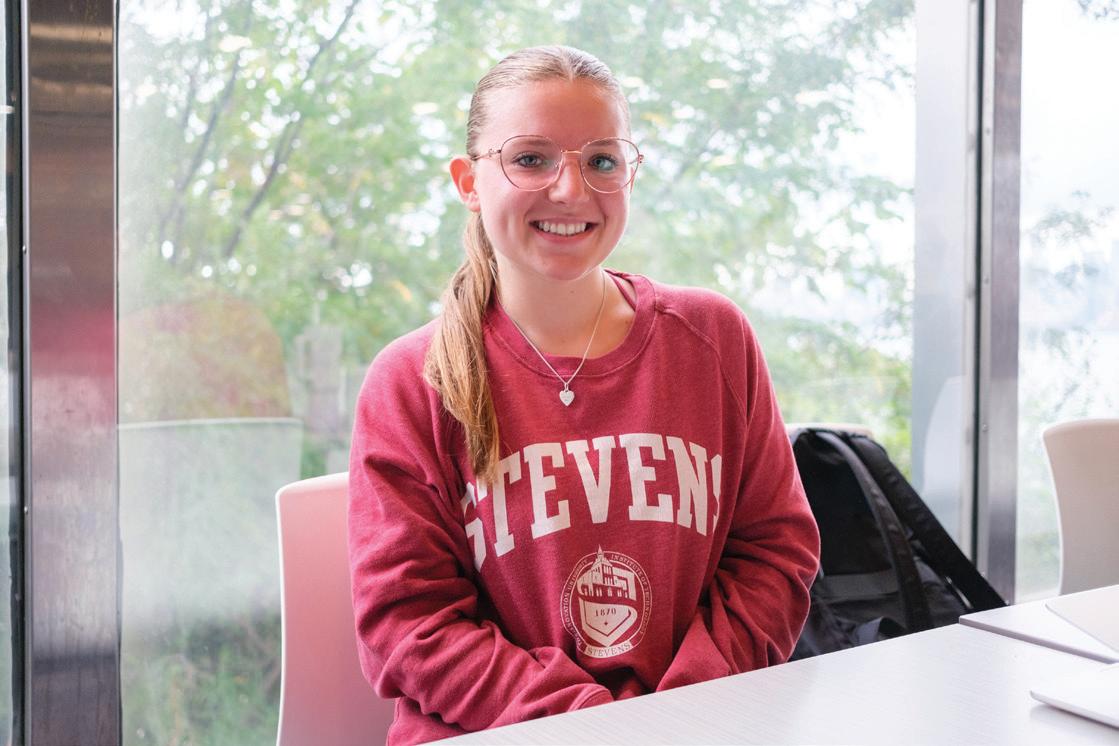
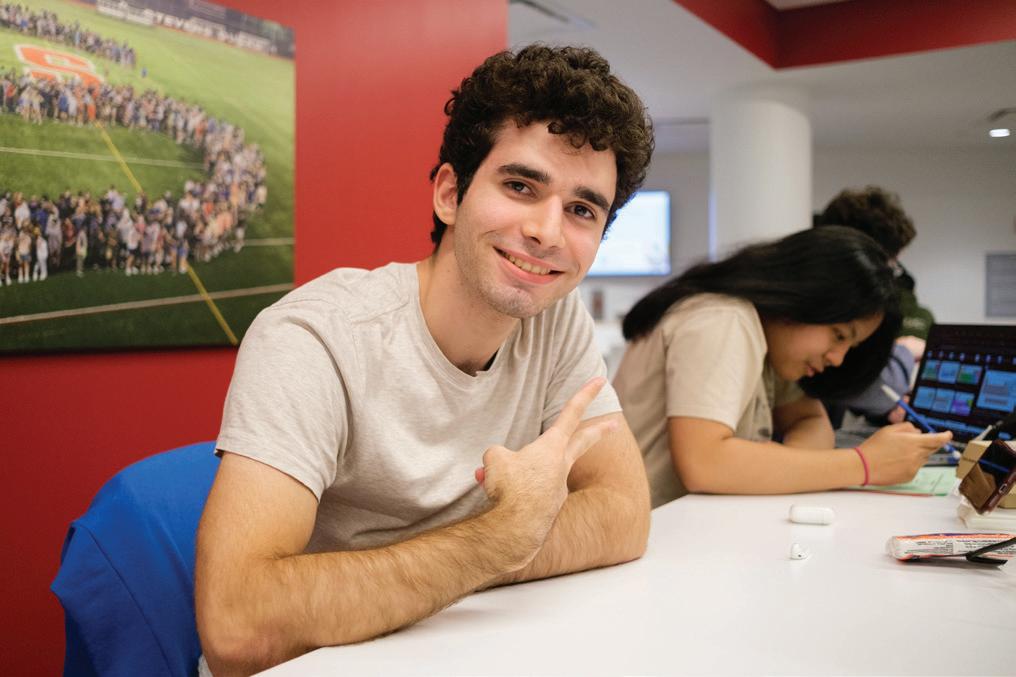
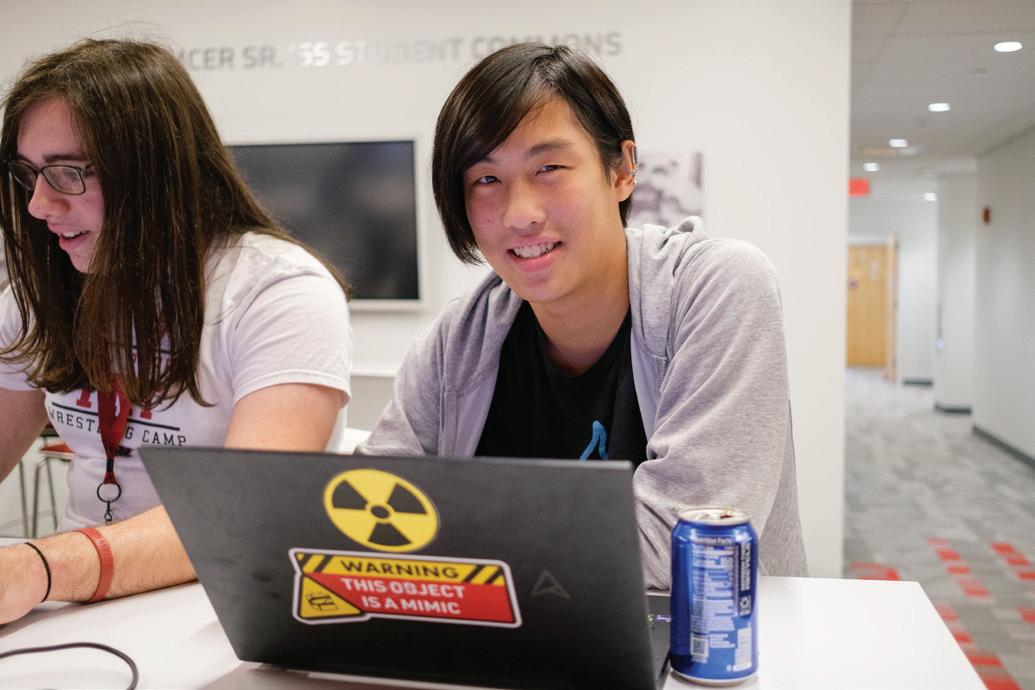
ROVING REPORTER
By Rafael Lee Li and Mia Petrolino
“Finish the sentence: it’s not fall until...”
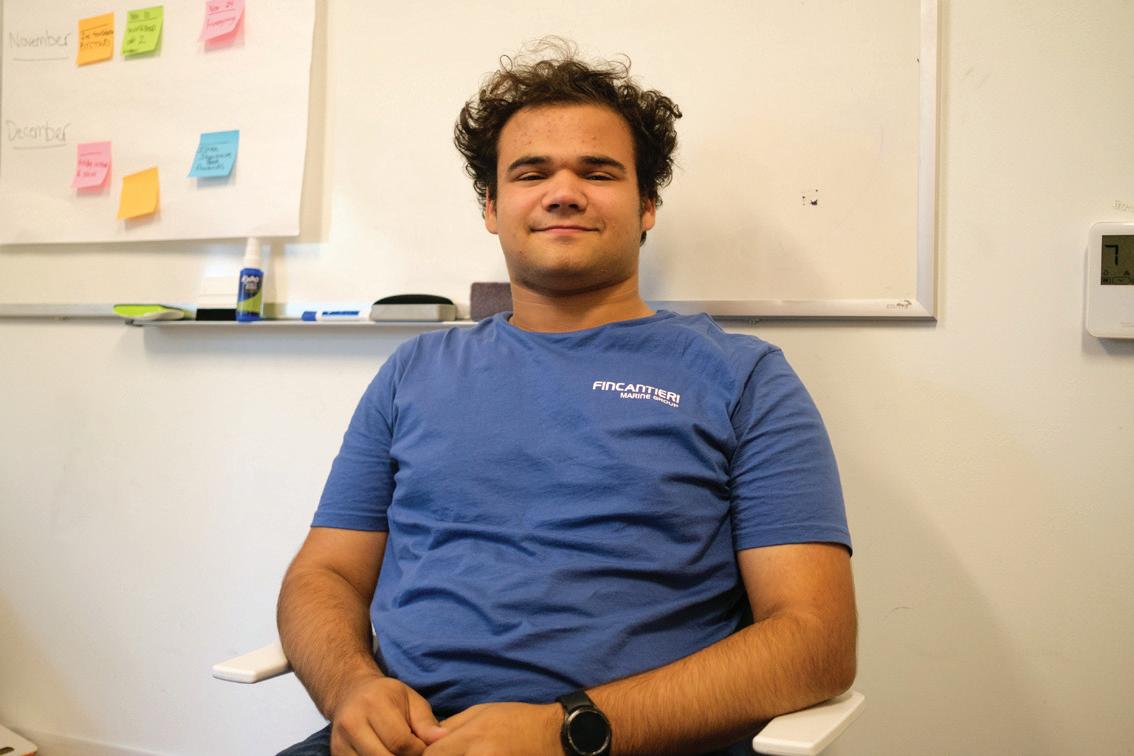

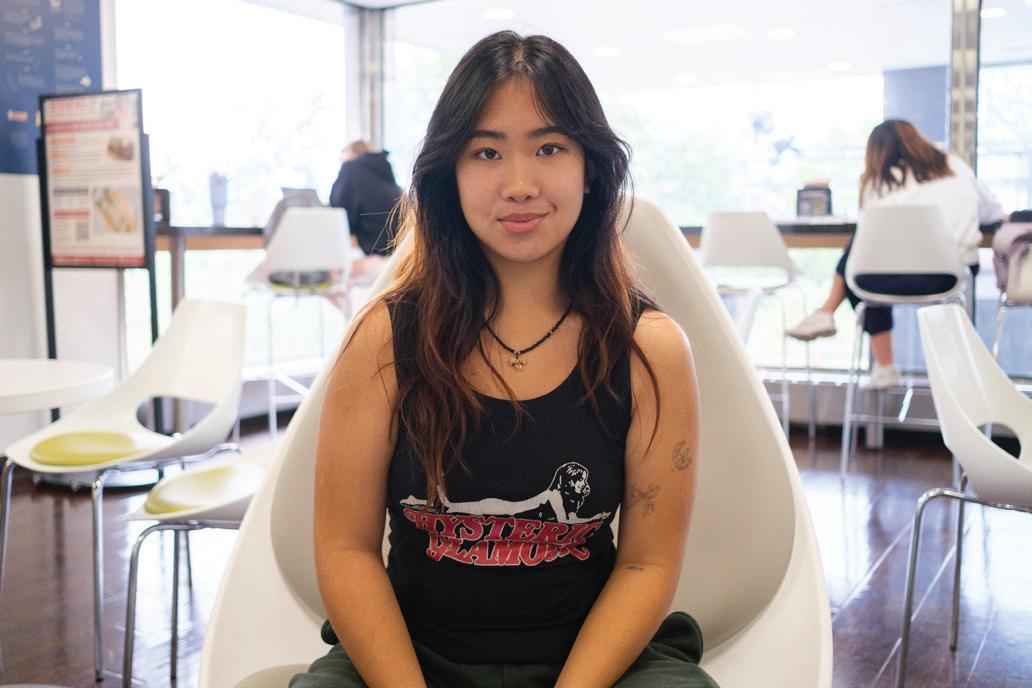
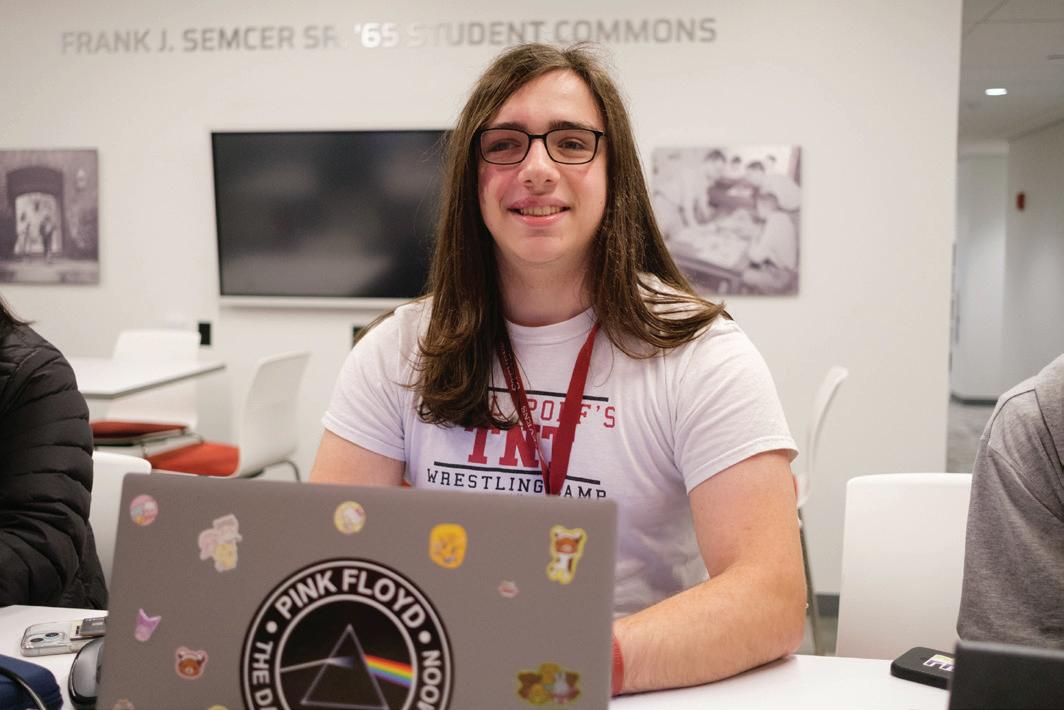
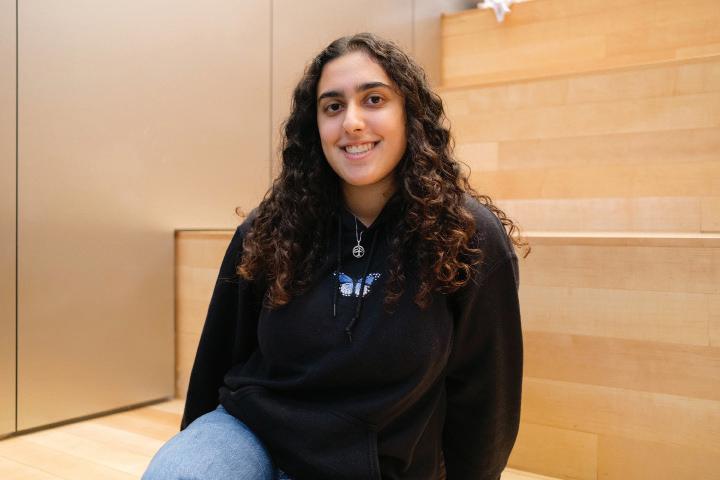
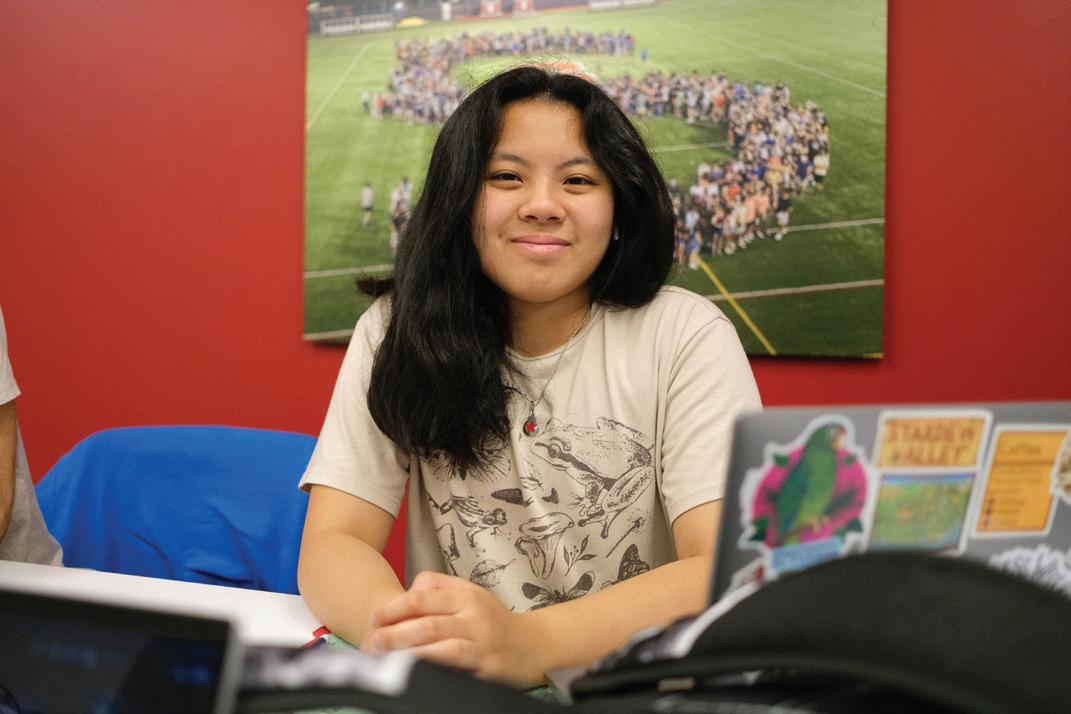
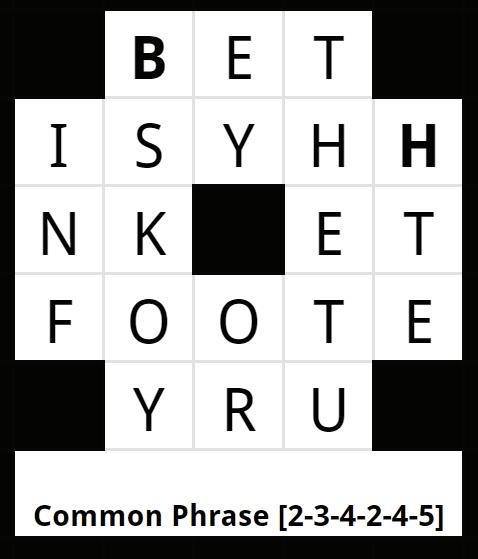
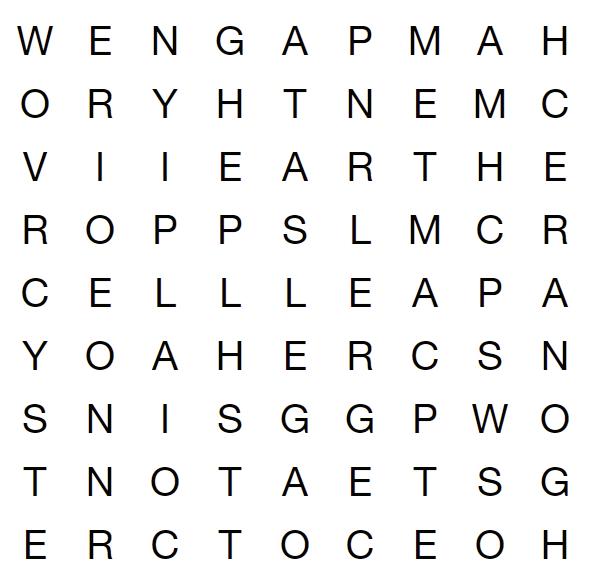


Vi Wong ‘28
“Until Mariah Carey starts singing.”
Diana Strama ‘25 “Starbucks starts selling pumpkin spice lattes.”
Erica Yang ‘28 “Until the temperature drops by 10 degrees.”
Jorge Wellesley ‘28
“Until I have to wear a hoodie to go to sleep.”
Gianmarco Costa ‘26 “Until you’ve gotten a pumpkin spice latte.”
Maria Mihalatos ‘25 “Until Snoopy comes to town.”
Shell DeCastro ‘28 “Until I can wear a sweater without sweating in it.”
Michael Terkanian ‘28
“Until my mom starts texting me about Christmas plans.”
